Known short crank Brunsviga machines
A picture exists in the Rechnerlexikon of a short crank Brunsviga B with a top plate that has been replaced much later. There is no serial number visible.

The earliest known Brunsviga was sold in 2002 by Auction team Köln. It is N° 73. Picture © Auction Team Köln.
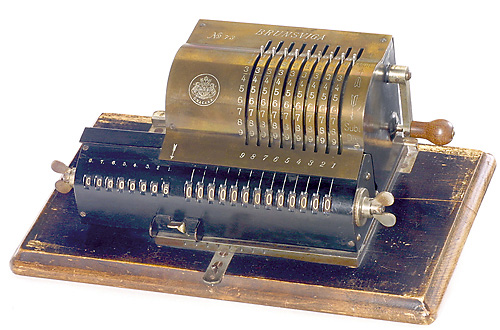
The next known machine was found by me on a trip to Vancouver, it's N° 110
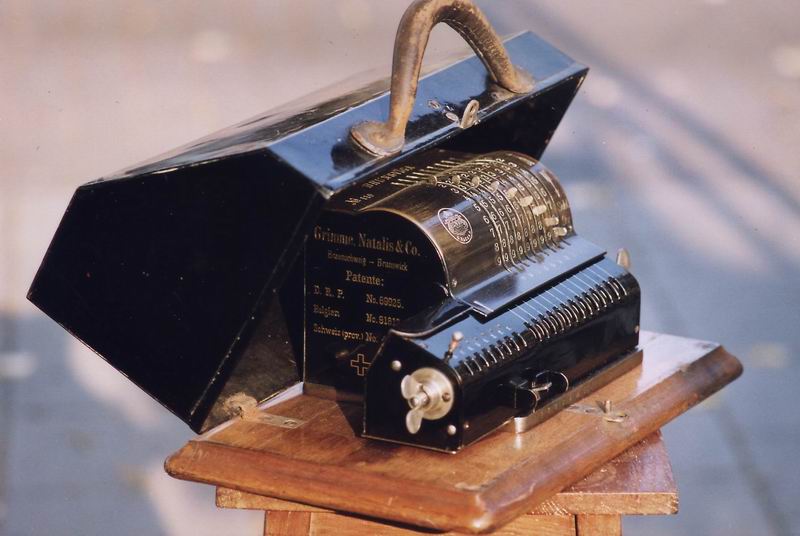
N° 118 was sold in the UK at the beginning of 2022
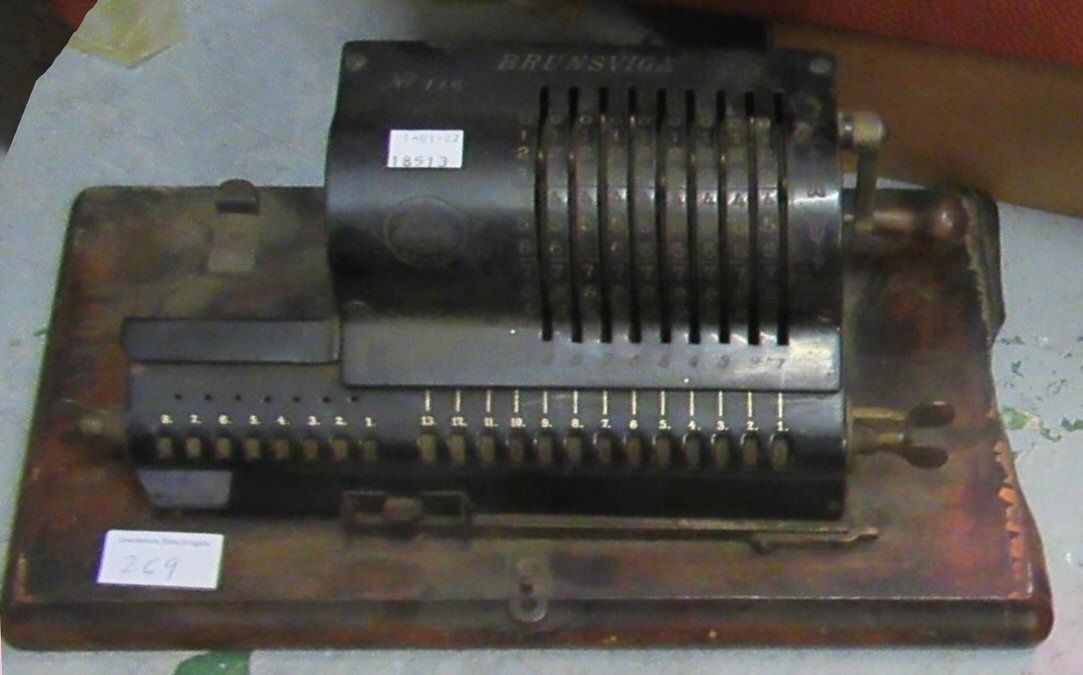
I was contacted by email by the owner of N° 131. It has been privately owned in Australia for the past 20 years - it's earlier history is unknown. There is no bell, and no dealer decal on the back. It has very small wingnuts on both sides, similar to n° 73 - the wingnut on the right of n° 110 was larger. Pictures © by owner.
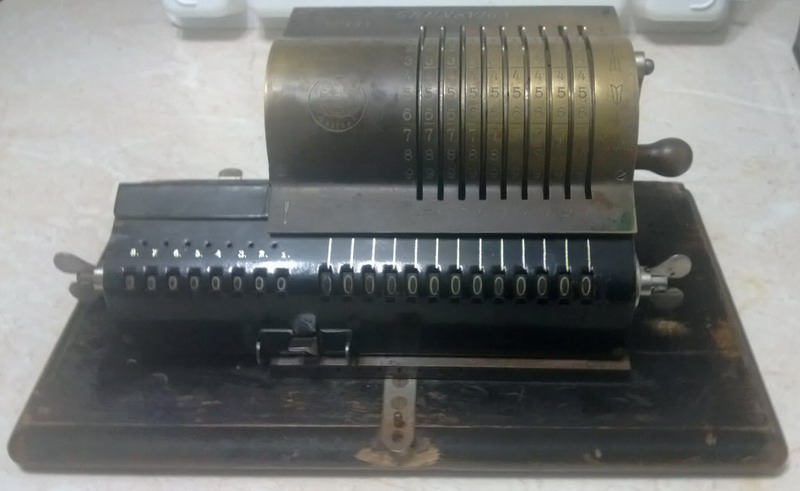

N° 143 is in a private collection in Germany. It has no bell, and the wingnut on the right side is the larger model.
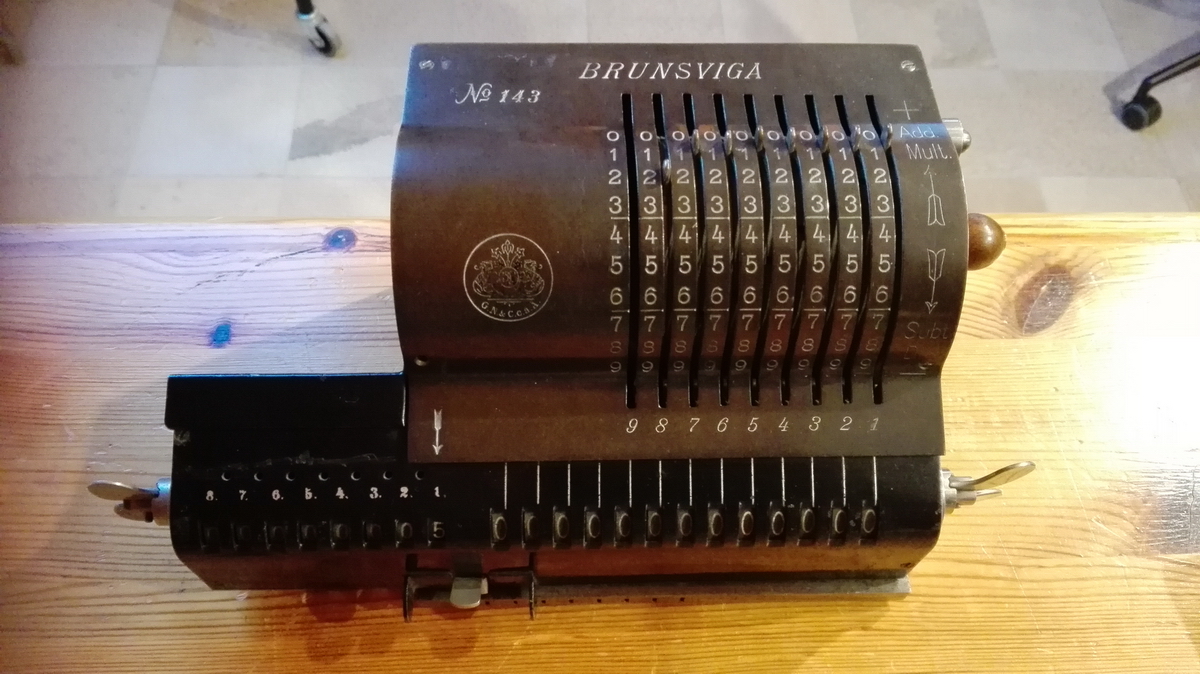
N° 159 is in the Tekniska Museet in Stockholm. (picture © Tekniska Museet, Stockholm, CC-BY license):
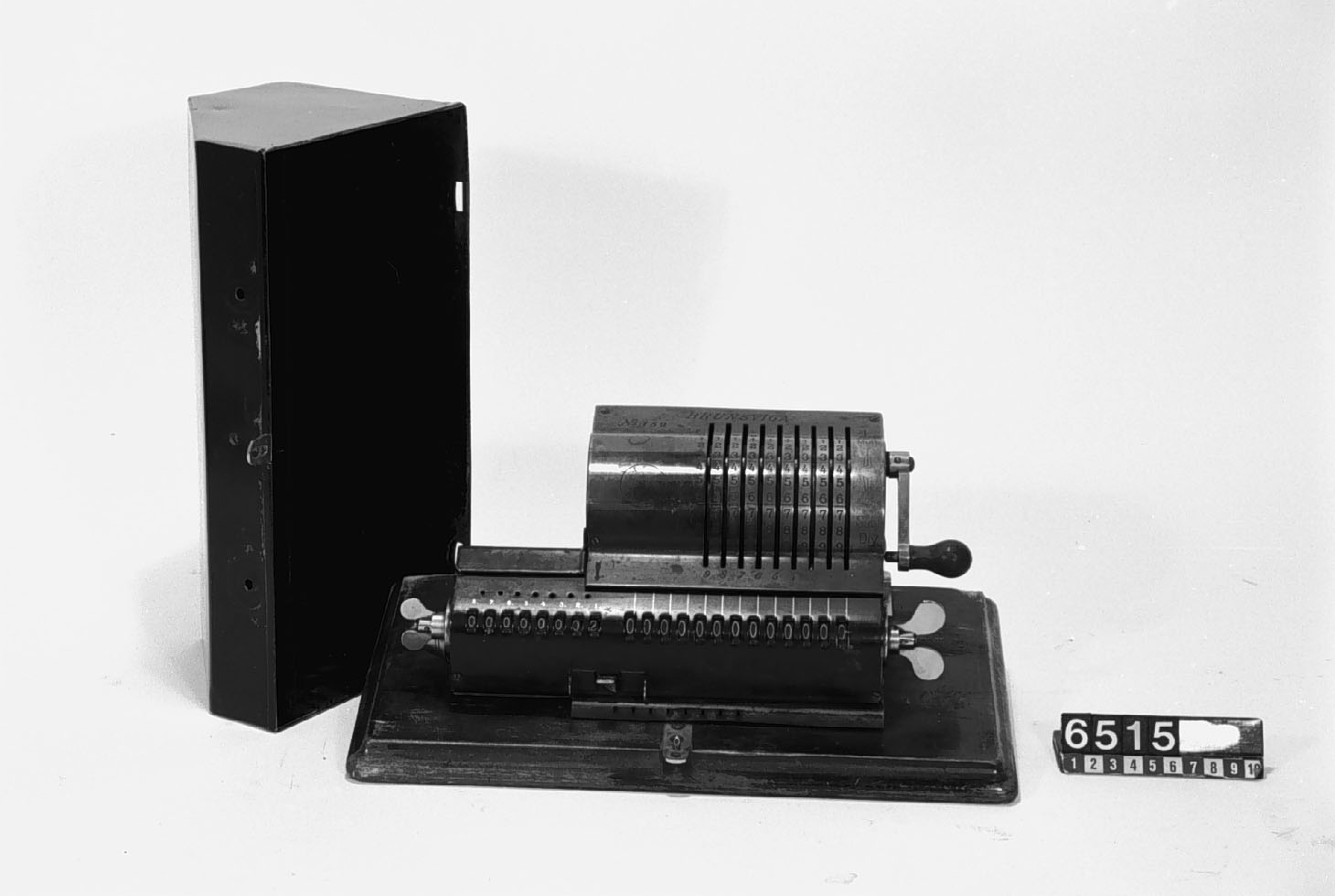
Do note that Brunsviga N° 159 has a bell - it is the first known machine with what would probably have been this optional extra. Also, the museum was able to provide me with some of its history. The machine was donated to the museum on Feb. 19th 1929 by an engineer at Åtvidabergs Stockholm Office, August Jansson, who must have realised its historical significance. The Åtvidaberg office probably received it in part exchange for a new Facit. Jansson sent a letter to the museum accompanying the calculator stating that it was first sold to a forester in Eberswalde, and subsequently sent to the Weichbrodt Company in Stockholm. It finally landed with the de Lavals Turbine Works in Saltsjö-Järla near Stockholm and was in use there up to 1929. You can see a picture of the factory, still exant, here, it is a beautiful building now converted to a conference centre.
N° 167 surfaced in an ebay auction in the UK. It has no bell, and the patent text on the side and sales agent name and address on the back are identical to N° 110. Images © ebay seller great4less.
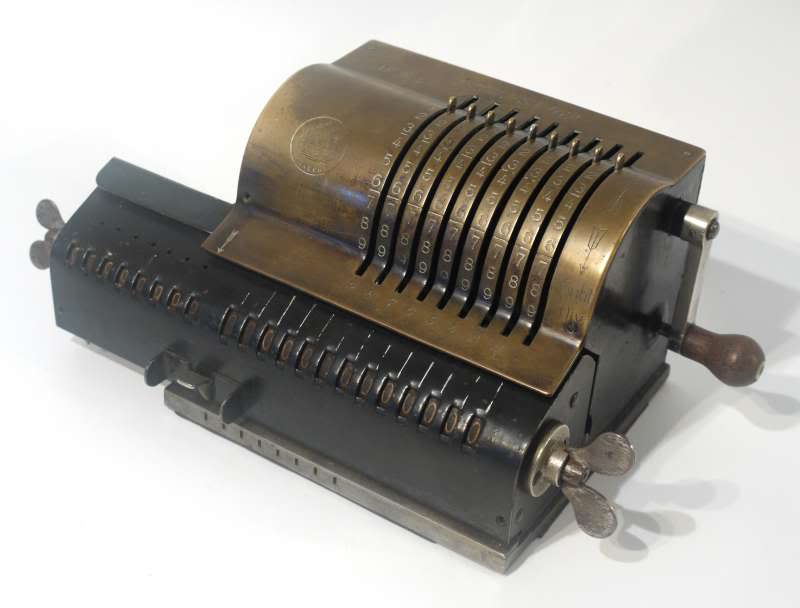
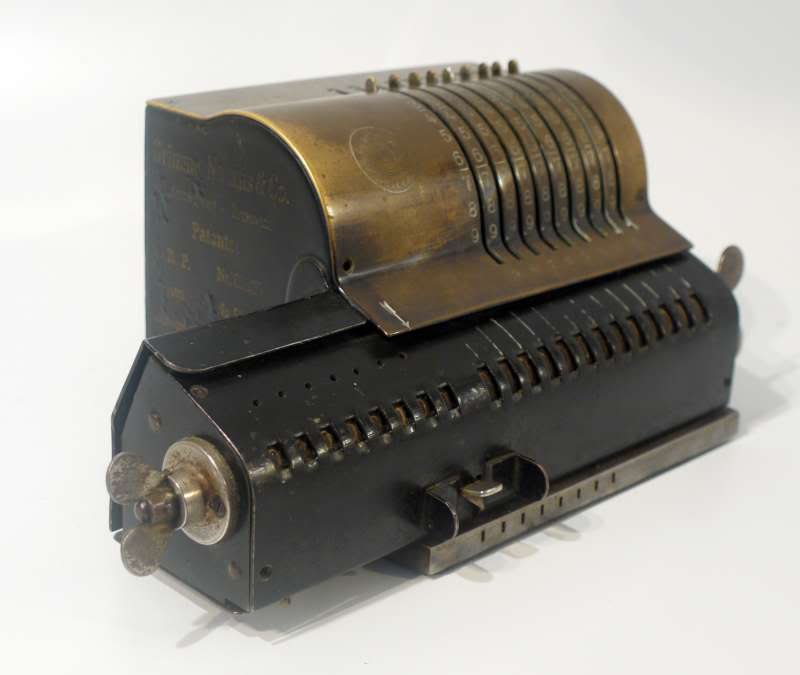
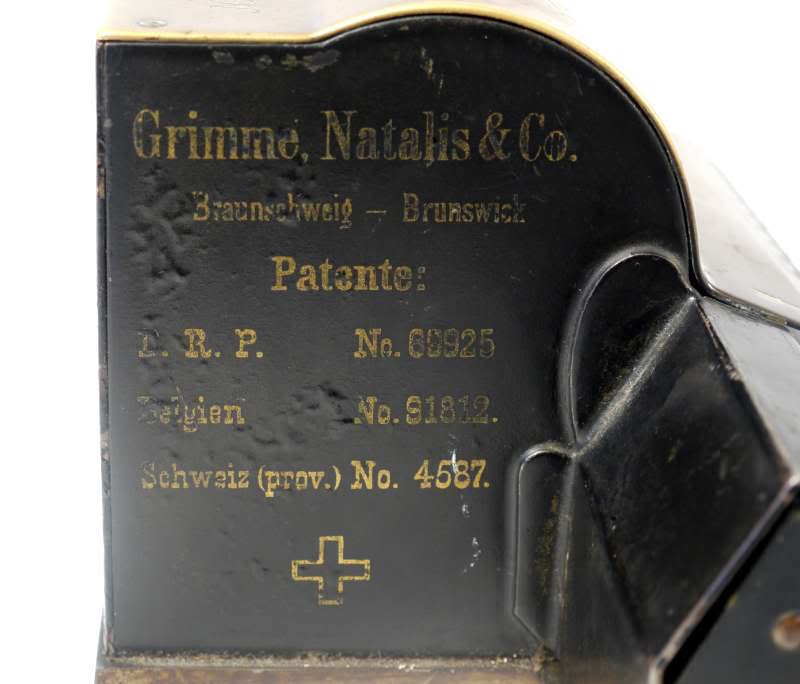
N° 202A has an extra A behind the serial number. Image courtesy of rechenmaschinen-illustrated.com
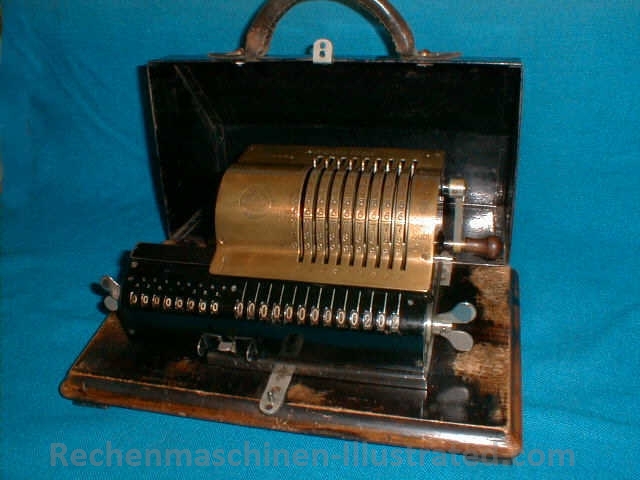
N° 214A was also sold by Breker in 2004 - pictures © Auction Team Köln. The locking button for the carriage appears to be a later type, and a comma slider bar was added.
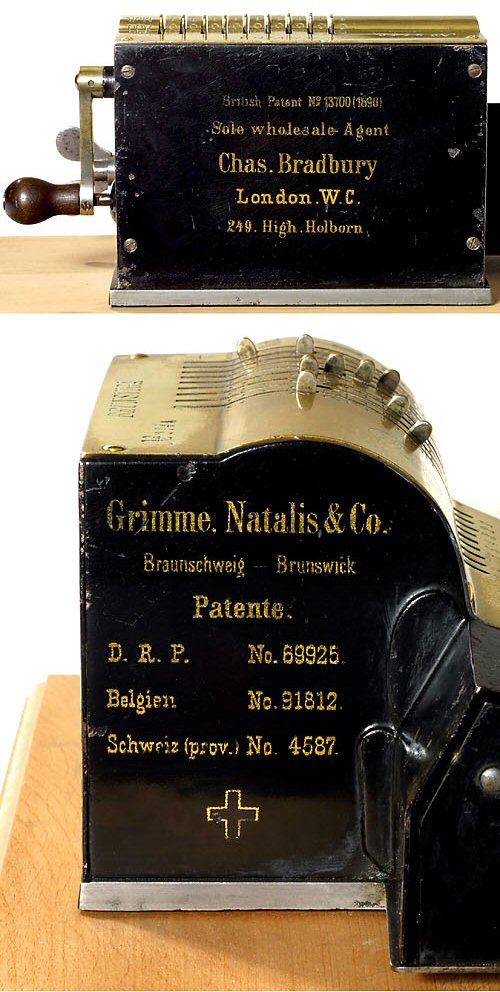
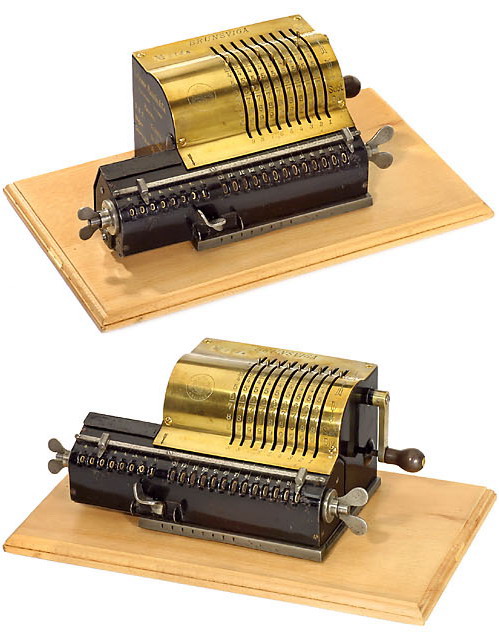
Intriguingly, also N° 224A has the A in the serial number. It is currently in a private collection in the UK. Pictures by owner, used with permission.
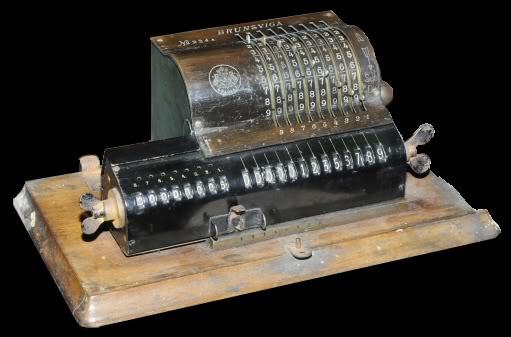
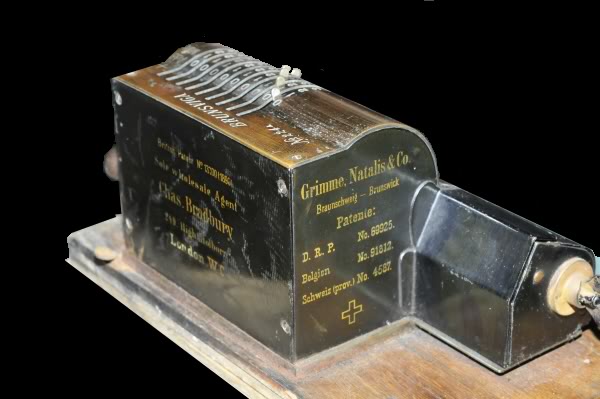
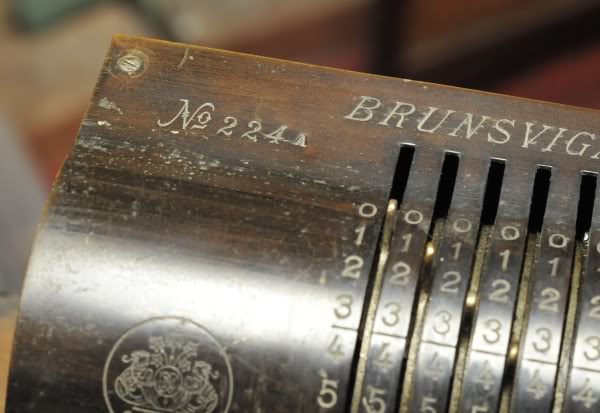
The university of Göttingen has Brunsviga N°225 (no A!) in the calculator part of its collection of mathematical instruments.
Interestingly, this machine has no bell, silver striping over the result register which is much wider than normal, as if it was added as an afterthought, and instead of comma holes and the silver stenciled numbers over the counter register, it has the silver dots there which are typical of early Odhner machines. It also has a very small wingnut on the right side, whereas any other early Brunsviga has a large one (except for the N° 73 and 131 - N° 110 has the large wingnut). Was the carriage exchanged for an earlier one ? For the carriage of an Odhner ? Yet another small mystery. The machine has very recently been professionally restored by Detlev Bölter. On his site more detailed pictures can be found.
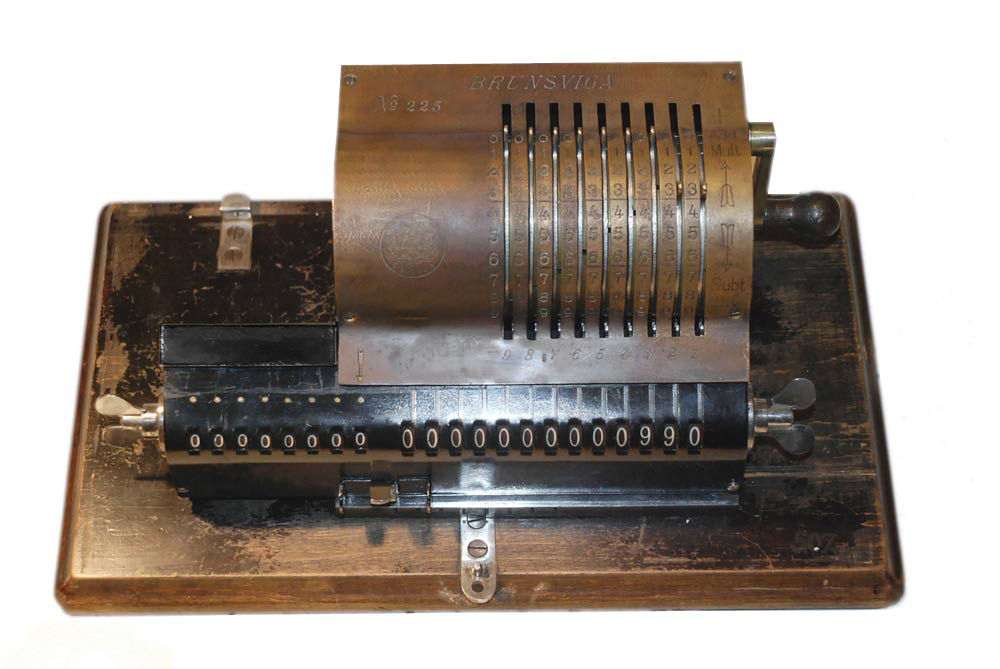
Brunsviga N°241A is in a private collection. Picture by owner, used with permission. It has a bell, the large wingnut on the right, a bright brass top plate, and an A behind the serial nr.!
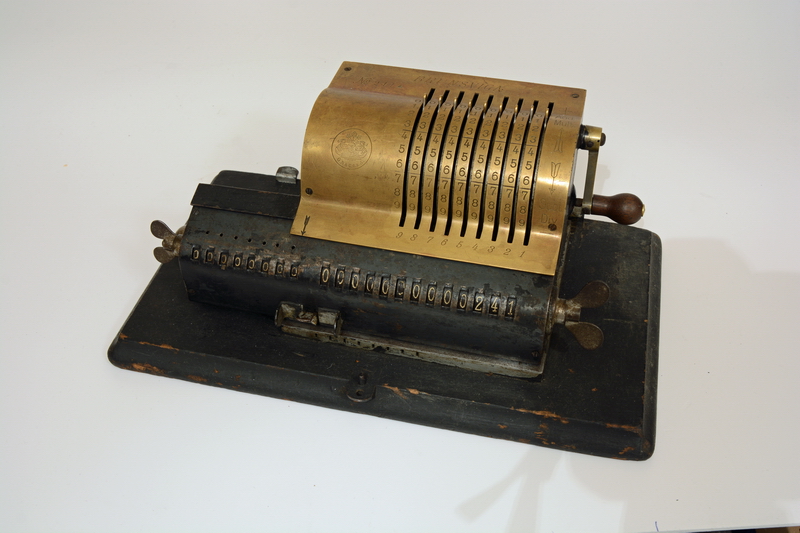
There is also a short crank Brunsviga in the Science Museum in London, with serial N° 262.
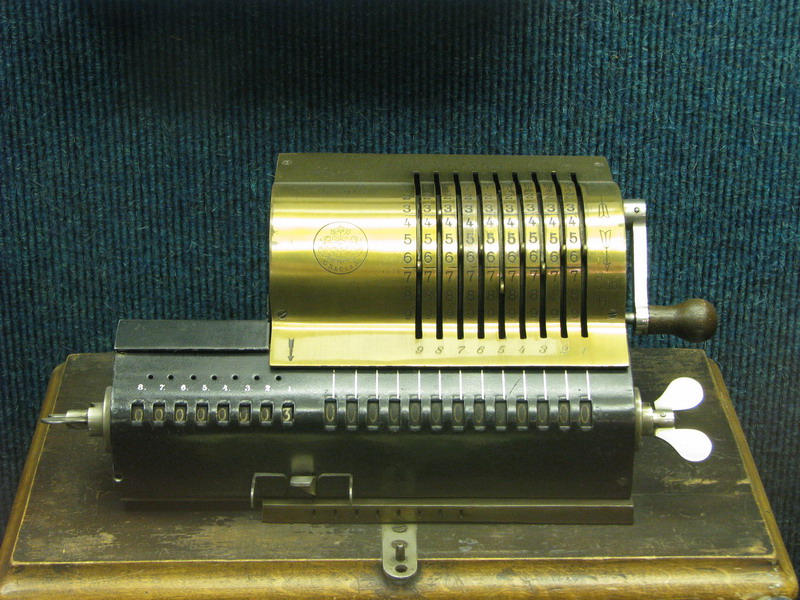
s/n 284 is in a private collection in Germany. I still haven’t obtained a picture of it.
Brunsviga N° 285 resides in the Arithmeum in Bonn.
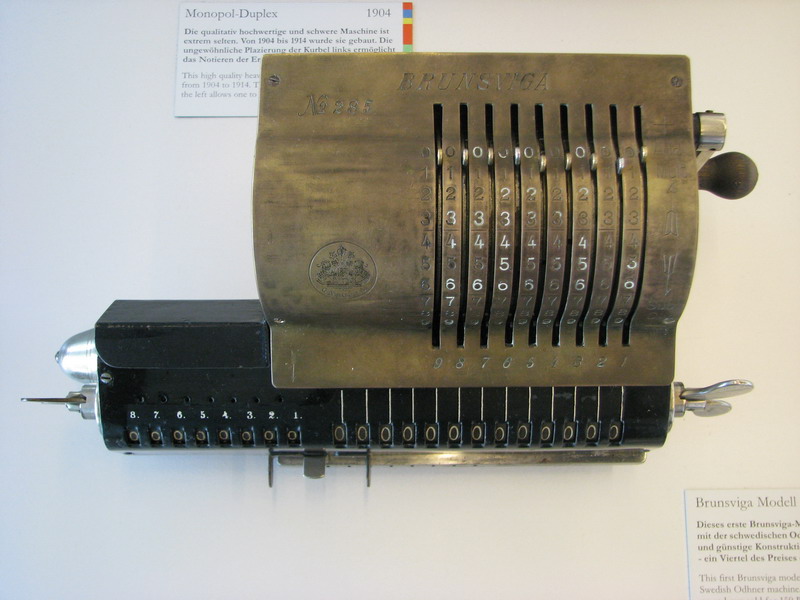
It also has a bell.
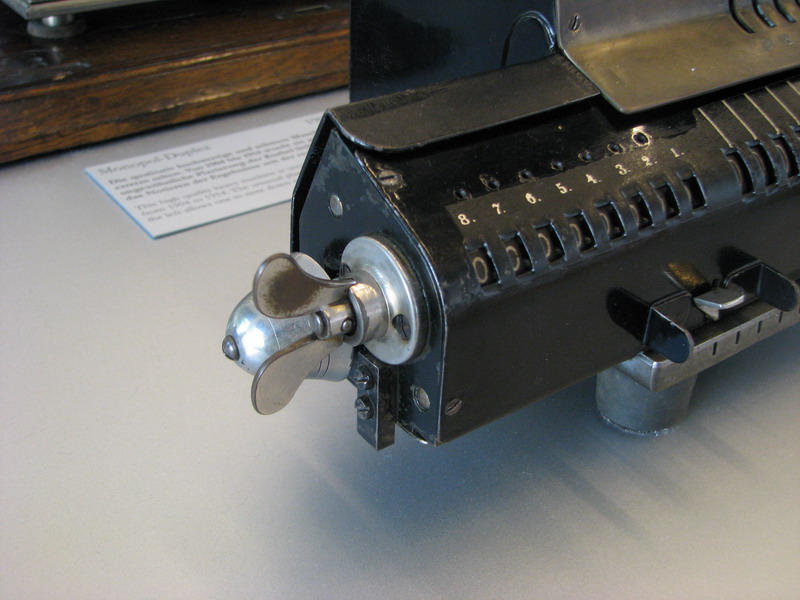
Brunsviga N° 291 was bought off ebay, after originally having been found on a fleamarket in Bonn. It is now in a private collection in Germany. Pictures by owner and used with permission. On this machine, the counter register clearing shaft wingnut is oriented horizontally in its rest position, and the wings are longer than usual. It is probably a later repair or replacement. The carriage shift knob is also of the larger type which is often seen on these machines.
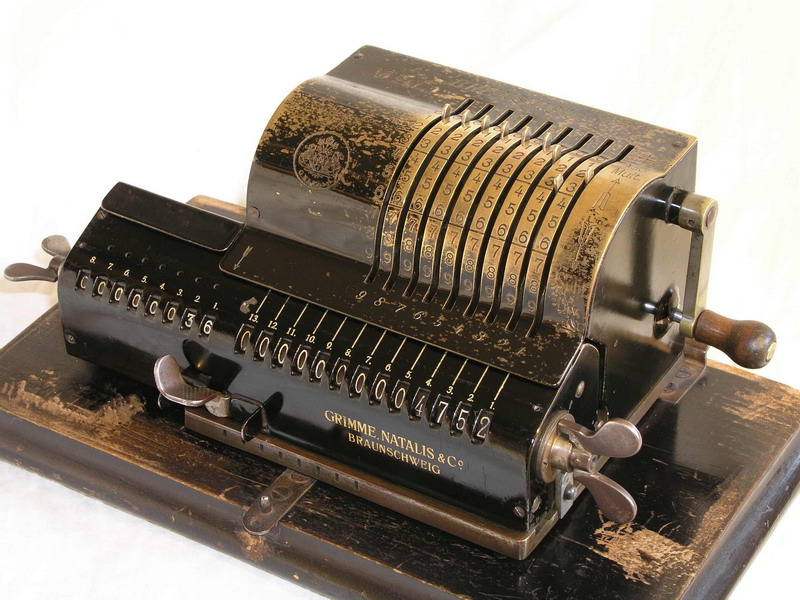
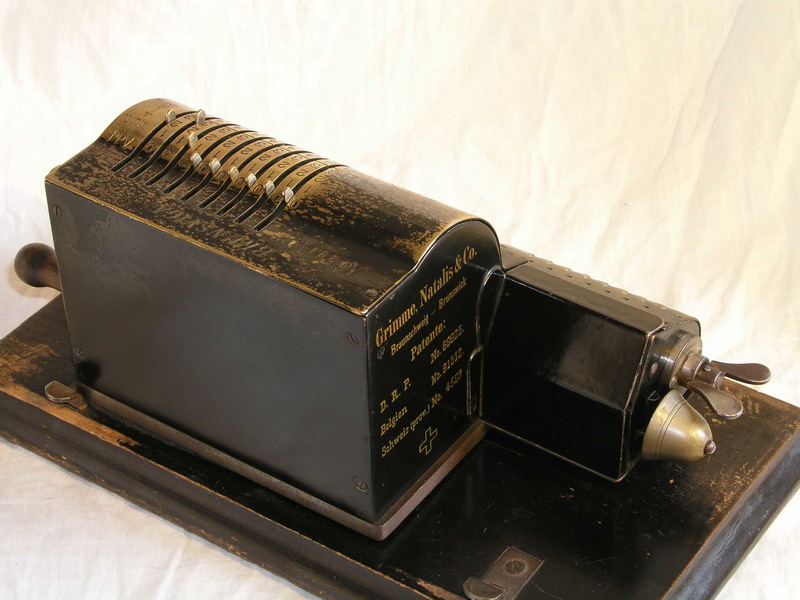
N° 299 is in the Norwegian Technical Museum in Oslo. There is a picture here (courtesy of the Norsk Teknisk Museum / digital museum project ):
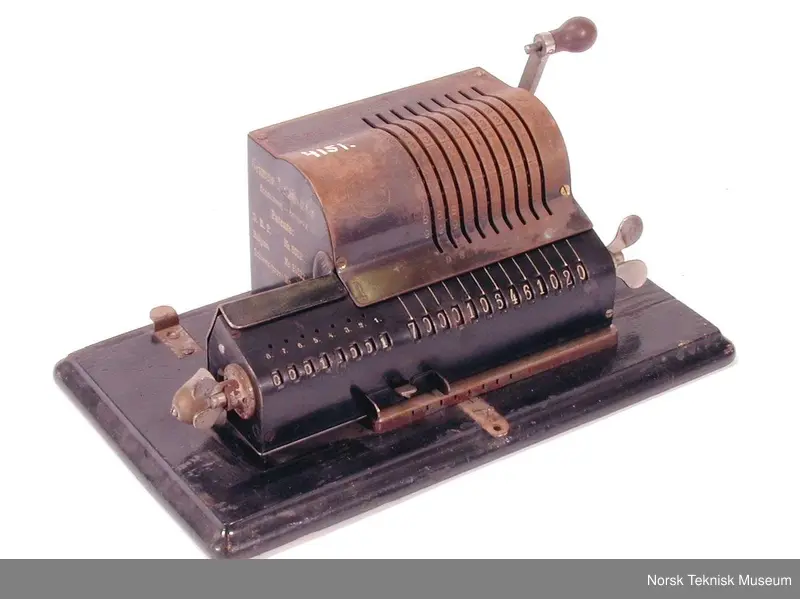
The catalog of the Royal College of Science, Mathematics department, in London, says they have N° 302, but unfortunately no picture.
...until one did surface in the catalog of the science museum group in 2021
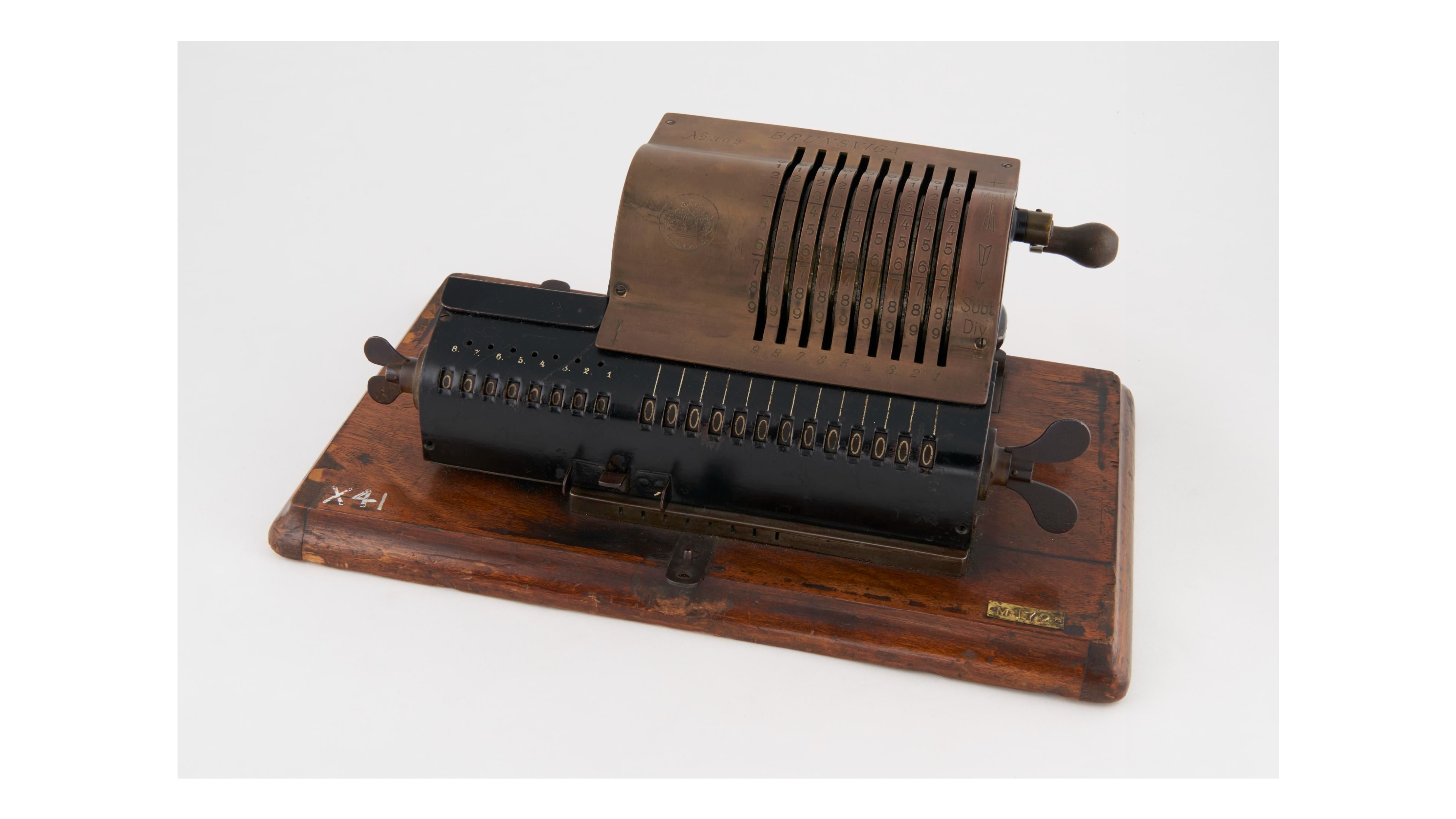
Also, this bad picture surfaced on ebay, apparently originating from the press-photo archives of the Olympia Werke.
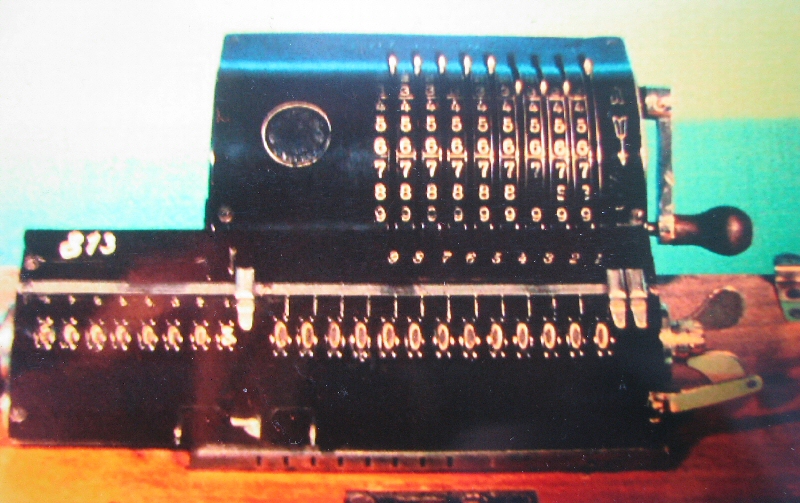
The sticker on the back of the picture mentions the machine was introduced in 1902, so they are about 10 years off at least on that. It is clearly a short-crank Brunsviga B, with a number (813) painted on the carriage in white. The picture is not sharp, and a serial number on the top plate is not visible. I was informed that this machine is in fact N° 308, and resided in the Braunschweigisches Landesmuseum (catalog nr. 813 - hence the paint). Comma sliders had been added to the carriage. The base plate, strangely, sports the new style of case lock. N° 342 and later short crank Brunsvigas still have the old style case lock. The machine is now in the collection of the Arithmeum in Bonn, as can be seen from the following picture, which was taken there (by me):
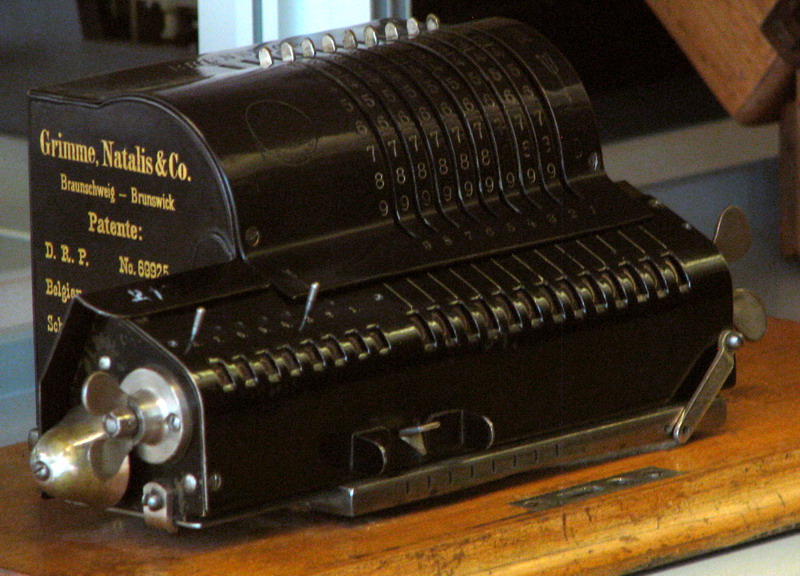
The comma slider bar has been removed, and the machine has received some comma indicators. Between the press photo, and the photo in the Arithmeum, also the wingnut on the right side of the carriage appears to have been exchanged for a larger one - or it may be an artefact of the photography. Odd.
A perceptive collector-colleague (thanks Maarten!) found a picture posted on Twitter by a UK computer shop in 2009, and thought he spied a short crank Brunsviga. He chased up the lead - the calculator was on loan for a workshop on early calculating technology, but the owner was traced, the machine photographed, and permission obtained for it to enjoy its celebrity status. Its serial number is N° 333, it has the Chas. Bradbury decal on the back, and on the side what is probably the earliest instance of the later decal listing many more countries. The chronology is a bit odd though, because my N° 342 has the earlier decal with only 3 countries, and so does N° 428. Was it perhaps changed when the machine was serviced? Anyway, N° 333 has no bell, the old style case lock, and now large wingnuts on both sides.
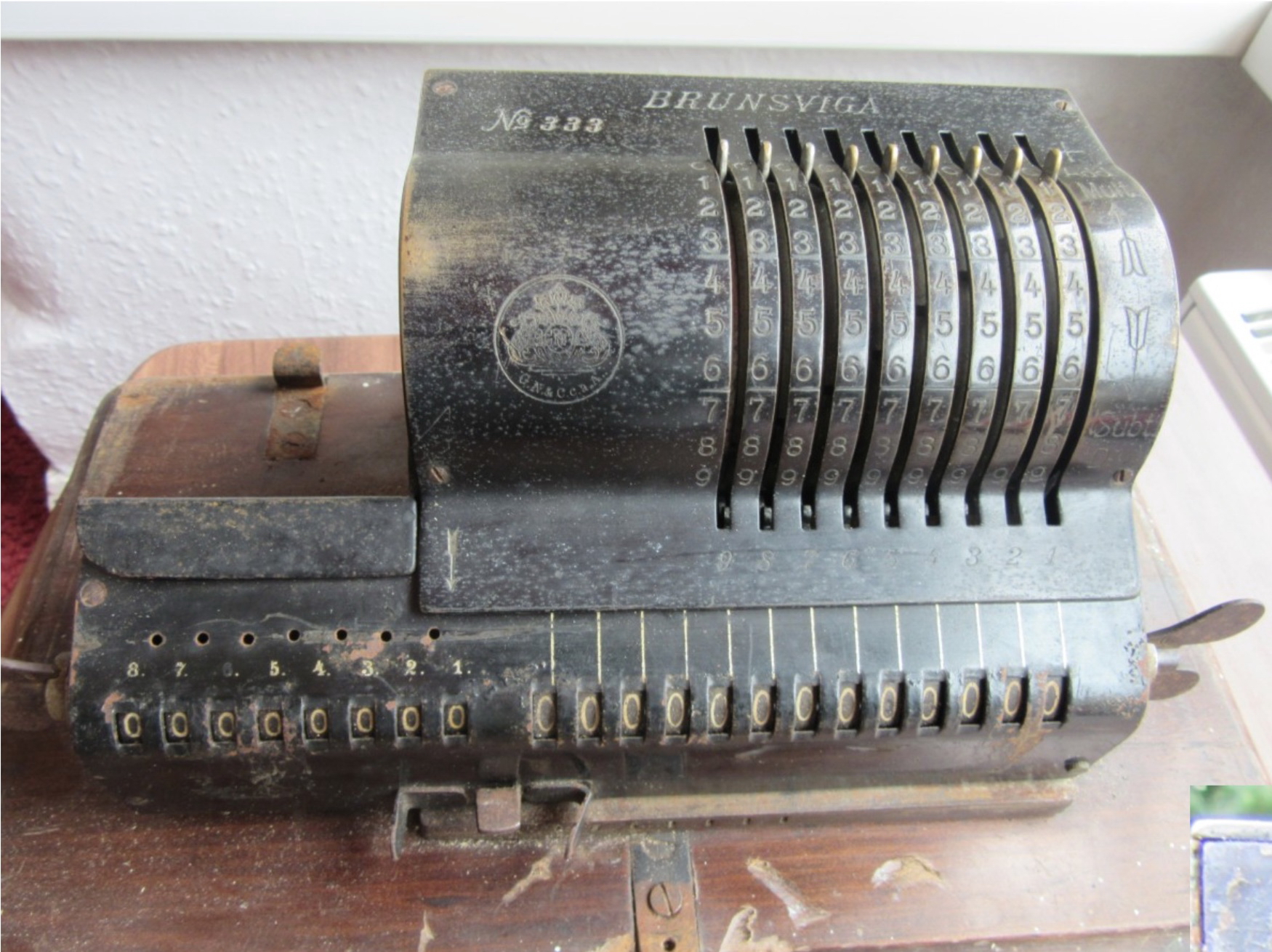
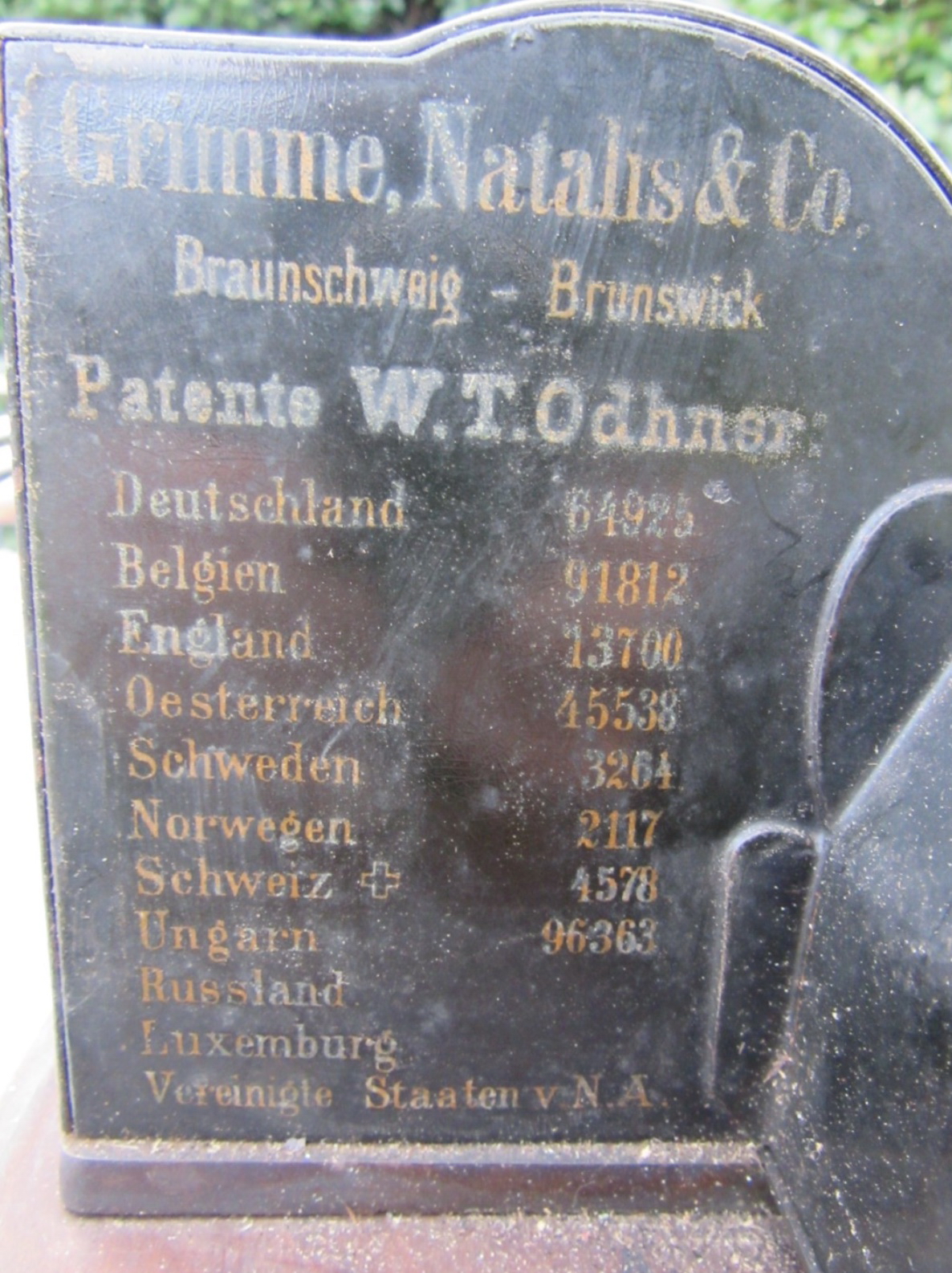
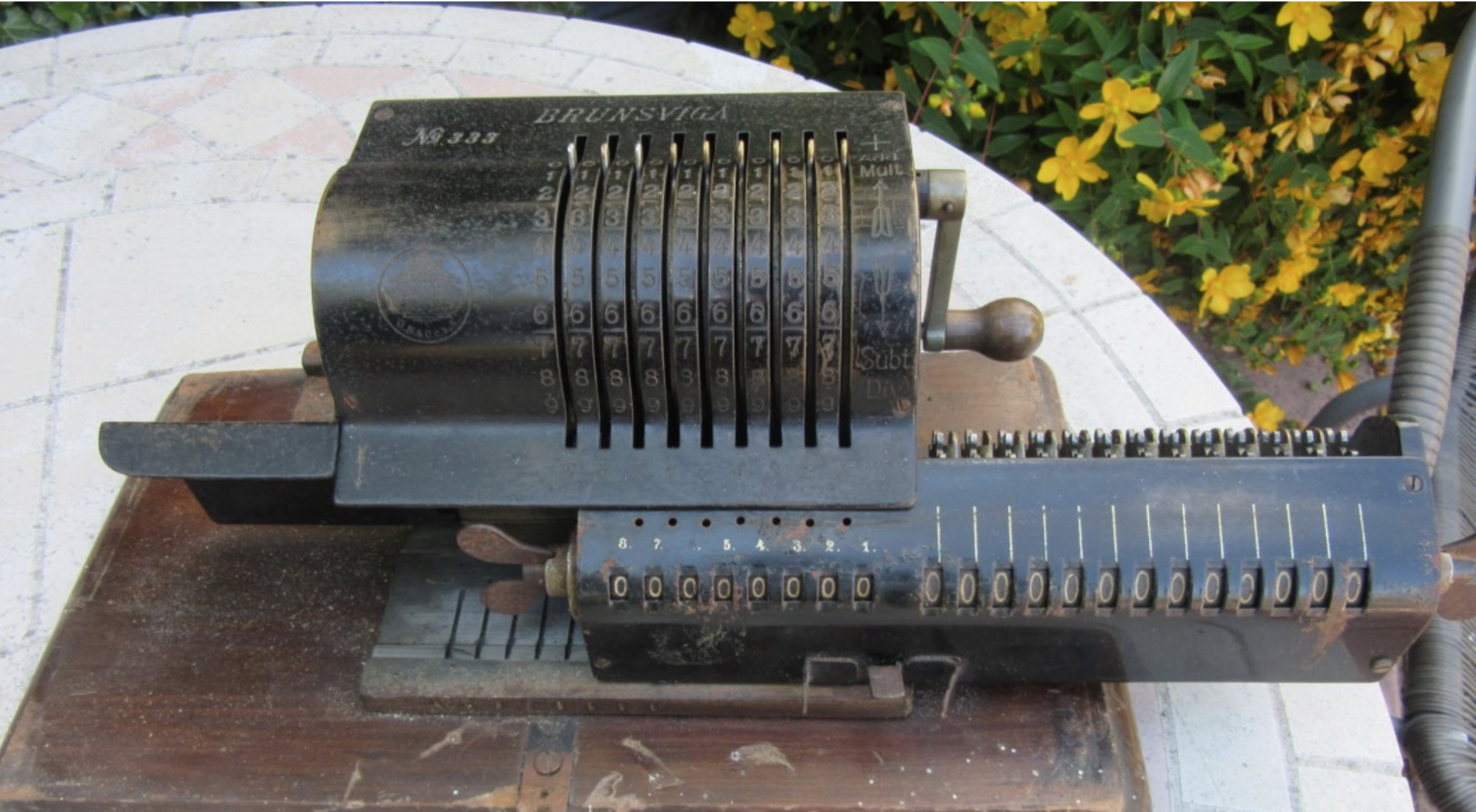
Brunsviga N° 342 is in my own collection, and details about it can be found on this page
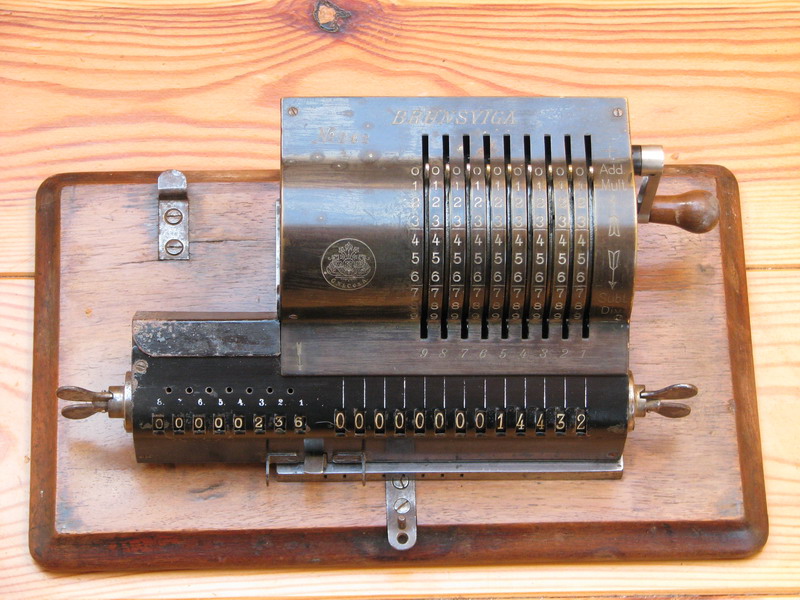
Another one spotted by my dedicated and tireless army of spotters (thanks, again!) - this time on kleinanzeigen.de. N° 352 is in a bit of a state - it is rusty, missing a number of screws, missing two numeral rolls on the left end of the result register, has received a replacement crank handle over the years, and is missing it's bell (which was originally there), but on the plus side, it still has it's case. The pictures are actually not good enough to reliably judge the size of the wingnuts, but it looks as though the right wingnut is a large one. It’s very odd that there are numbers at the bottom of the stripes on the result register ... this re-occurs in N° 370, but not the machines in between.
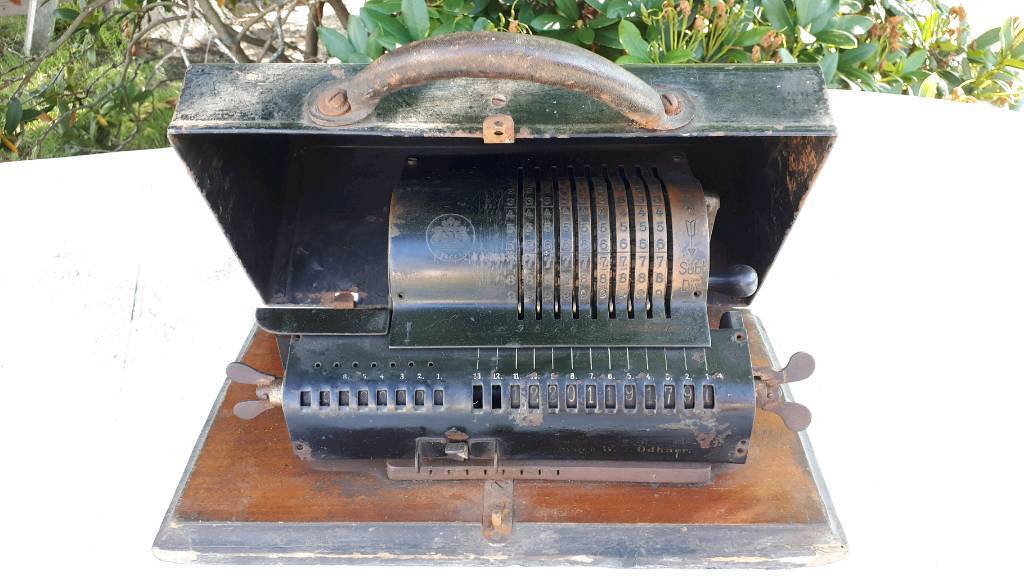
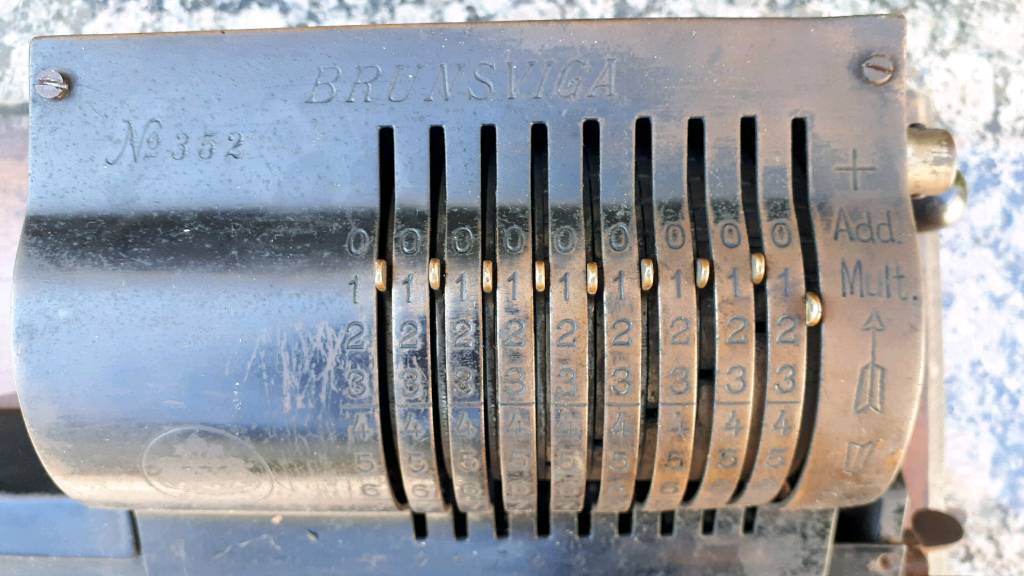
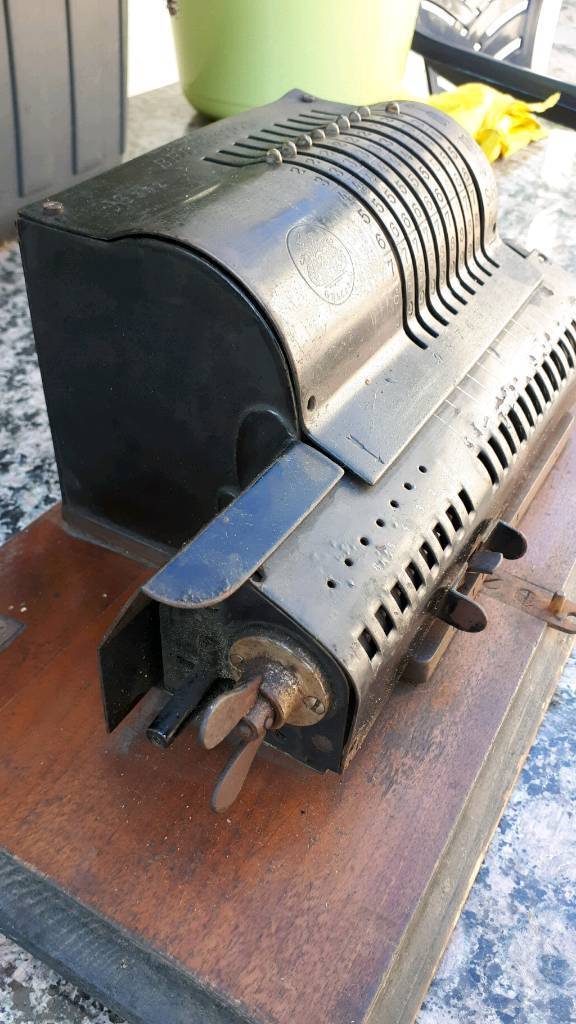
Brunsviga N° 364 appeared on ebay in 2021 from a collection in Germany.
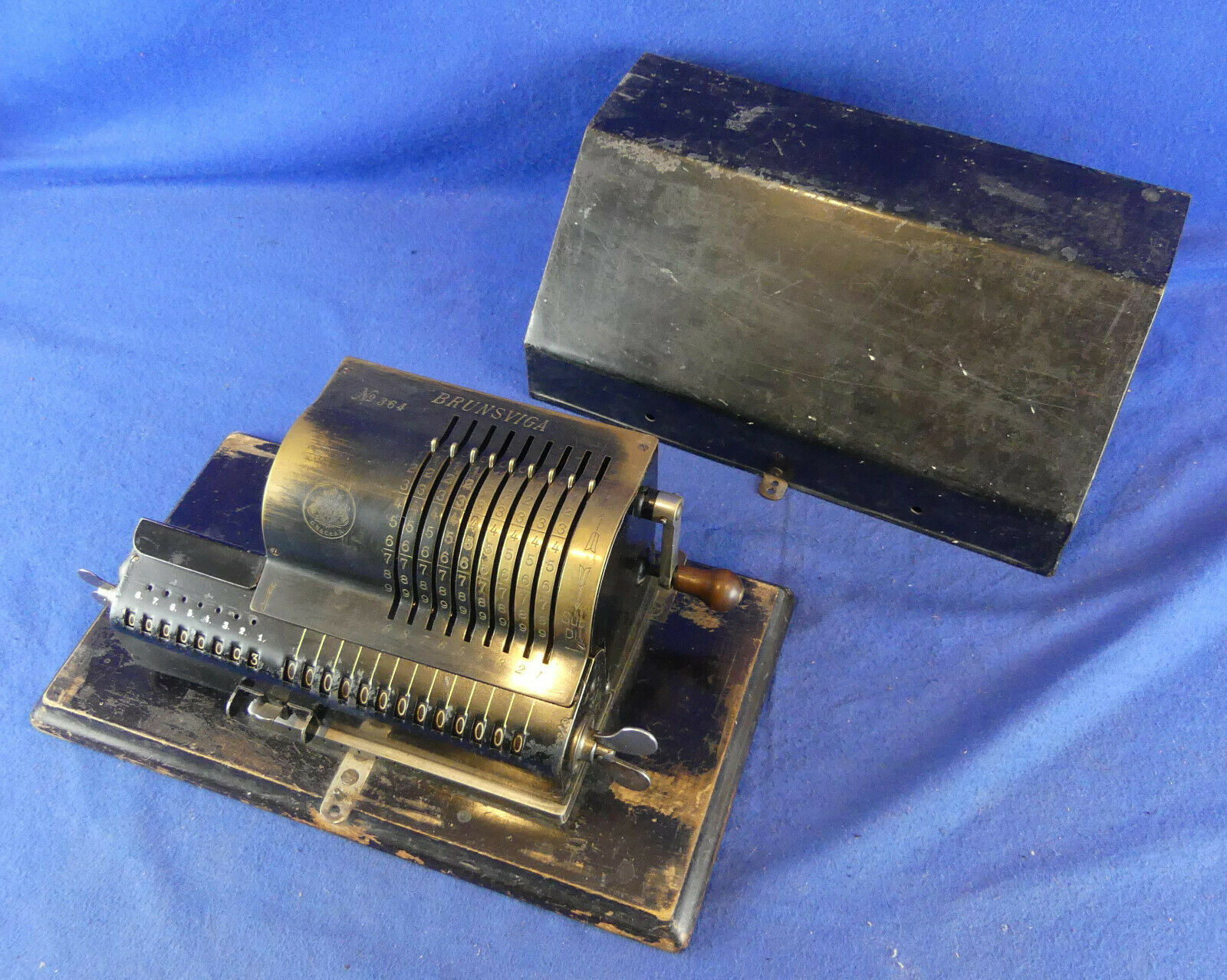
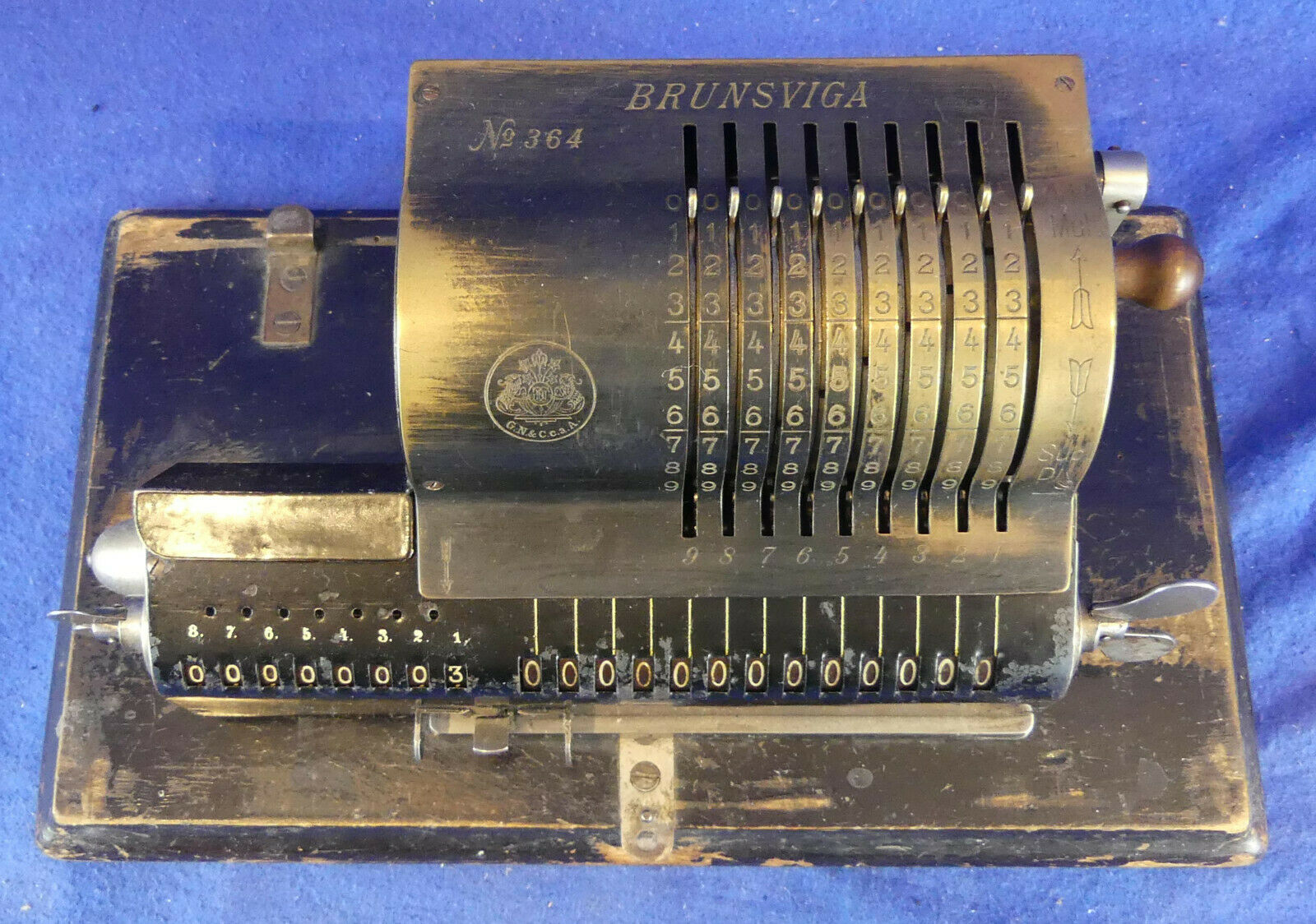
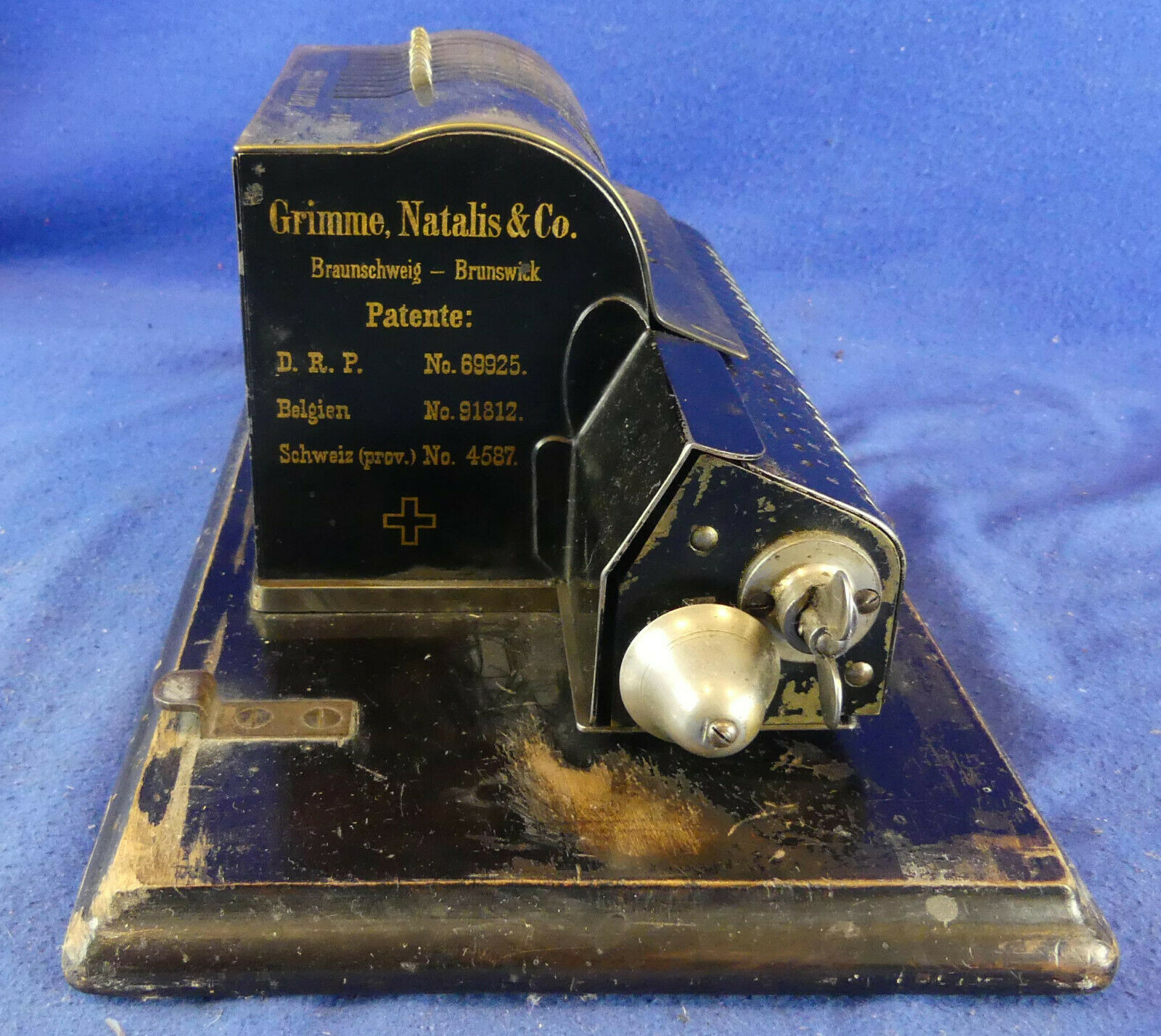
Another unlikely sighting - on Tripadvisor, there was a picture of this early Brunsviga B, under the Astronomical Observatory of Quito, in Ecuador. An inquiry by email later, we now know that it is Brunsviga N° 365 (a very apt number for an astronomical observatory, one might add). It is also makes up half of one of the two pairs of adjacent serial numbers.
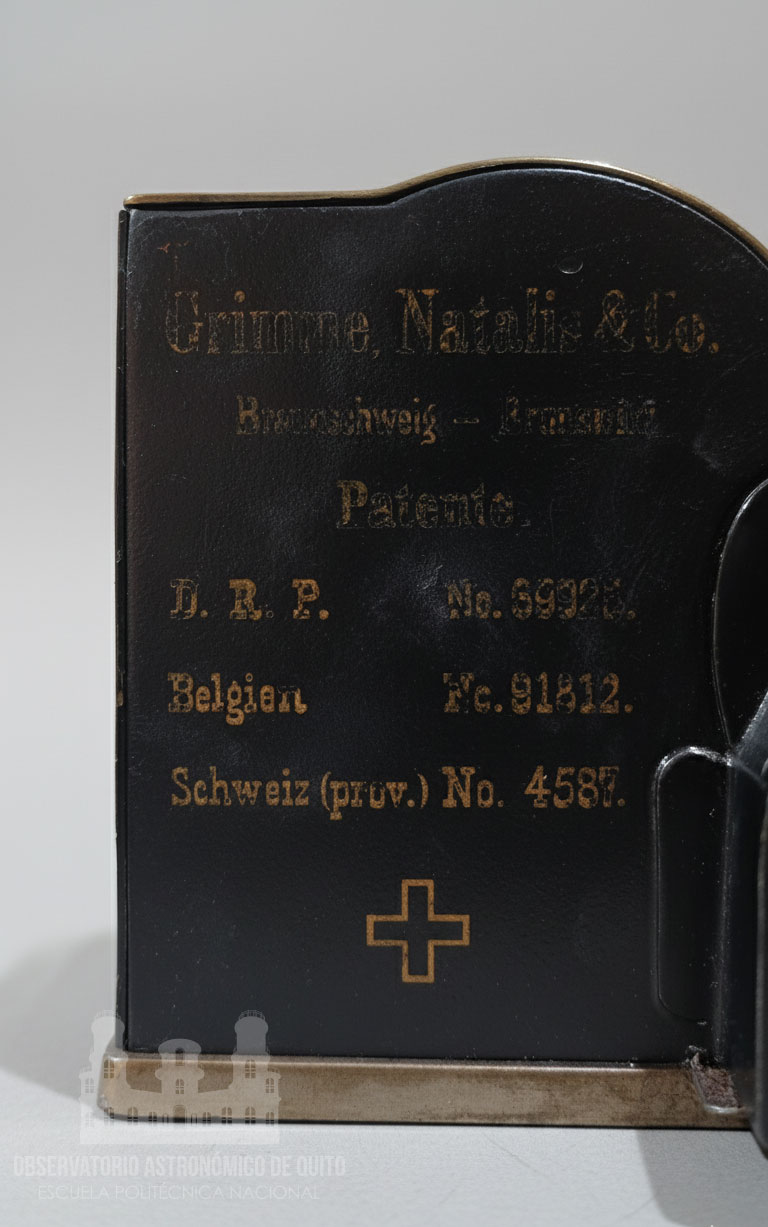
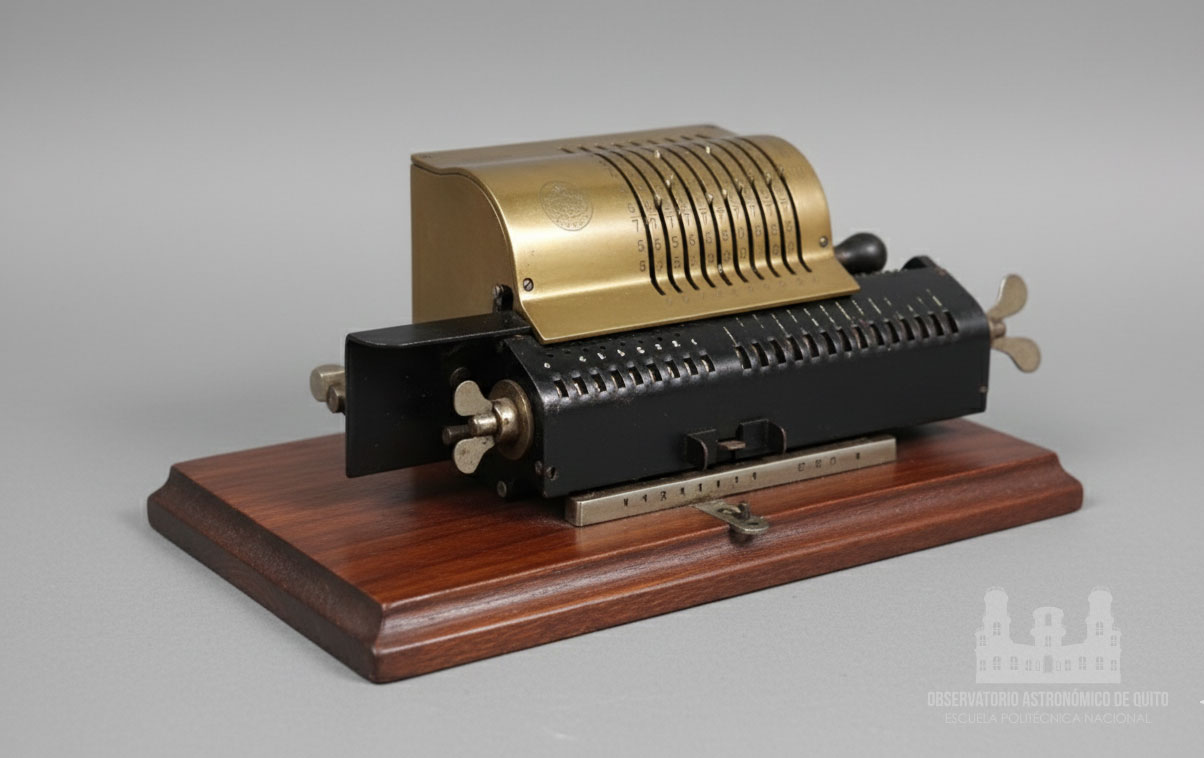


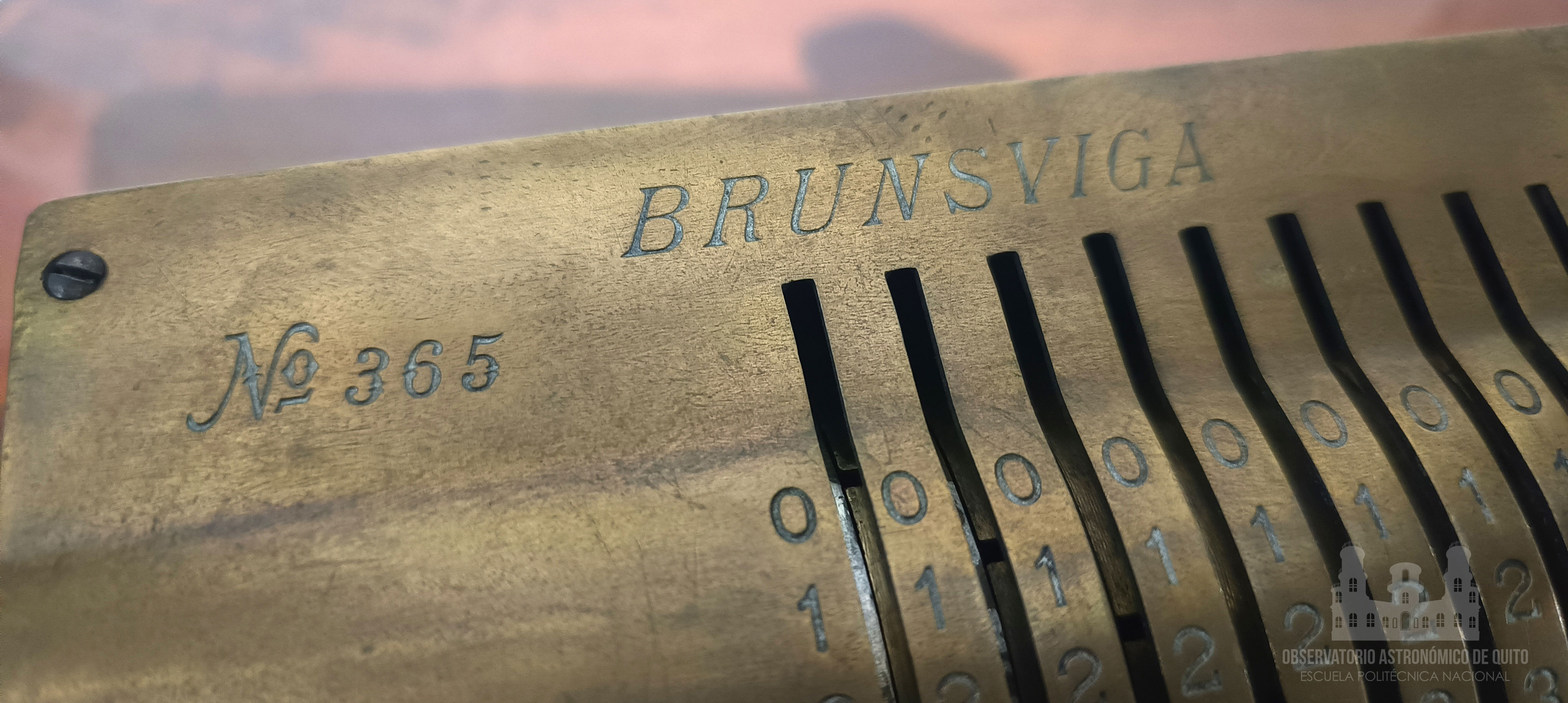
Images are copyright Observatorio Astronómico de Quito, and used with permission (and thanks!)
Brunsviga N° 370 was sold at auction, and bought by a US collector. It is the only short crank machine I know with a nickeled top plate. The decal appears to be later, and so is the numbering on the result register (as in N° 352).
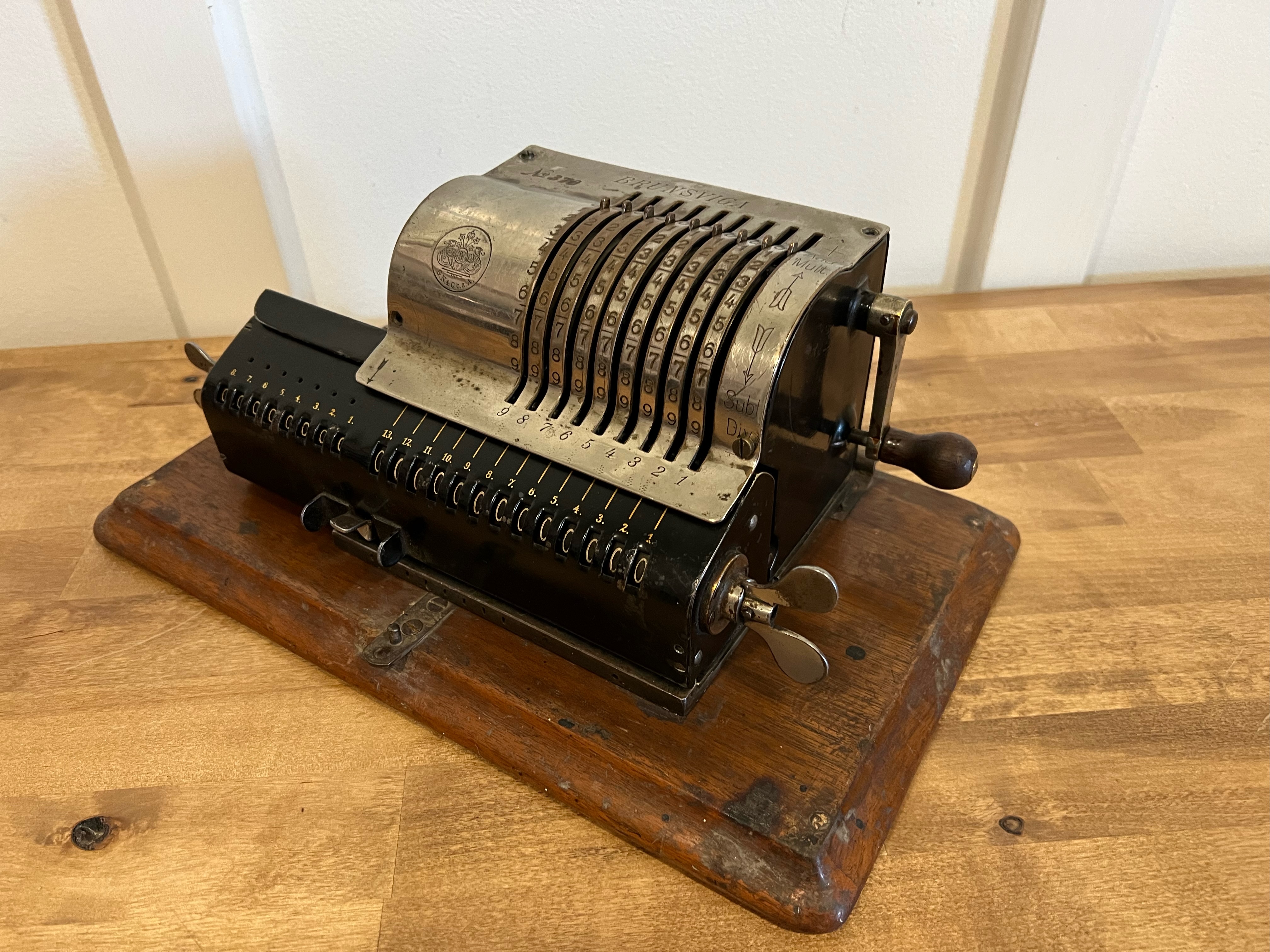
Brunsviga N° 391 was sold in the US, to a Dutch collector. The machine has a bell, and the small carriage shift knob, and a larger result register clearing wing nut.
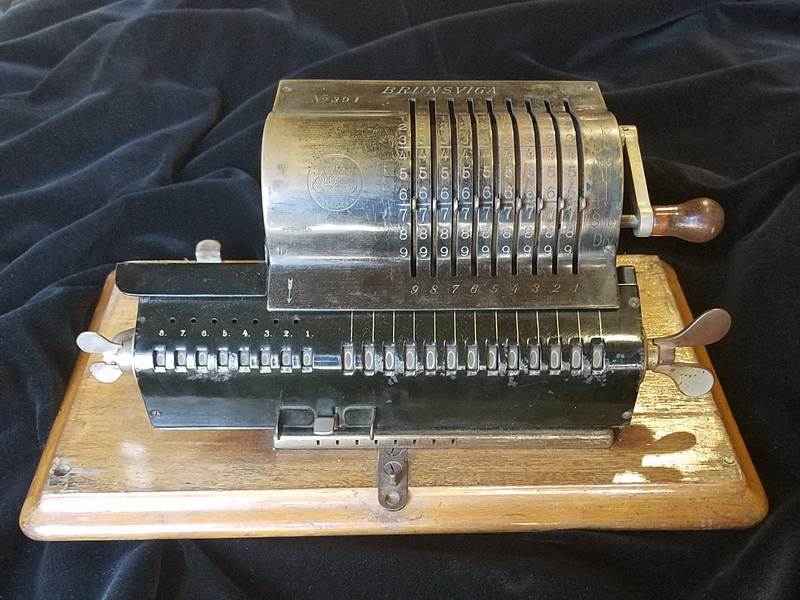
Picture copyright House1002
Brunsviga N° 407 was in the collection of the Braunschweigisches Landesmuseum and appears in a catalog from 1981, from the exposition "Rechenkunst und Rechentechnik" from the Deutsche Forschungsgemeinschaft at the Wissenschaftszentrum Bonn. This machine has no base plate, a different carriage shift knob, and larger wingnuts on both sides.
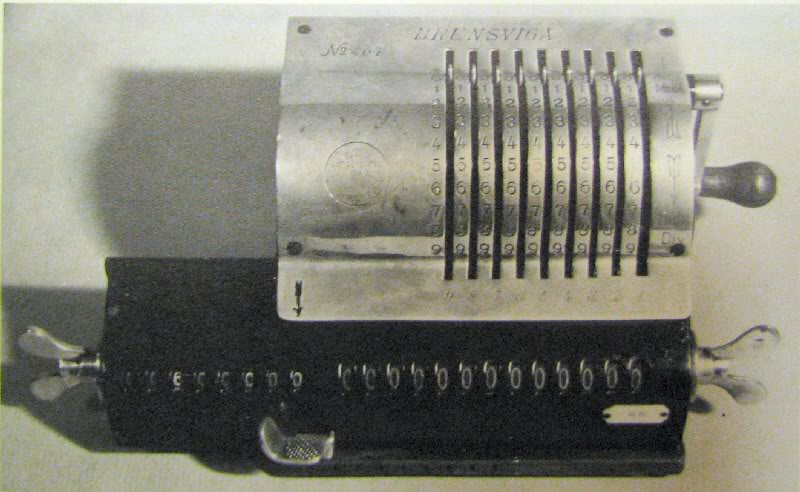
Brunsviga N° 428 is in a private collection. It is the last known example so far with a short crank. It also has large wingnuts on both sides, no bell, and again the old style case lock. More pictures appear on rechenmaschinen-illustrated.com.
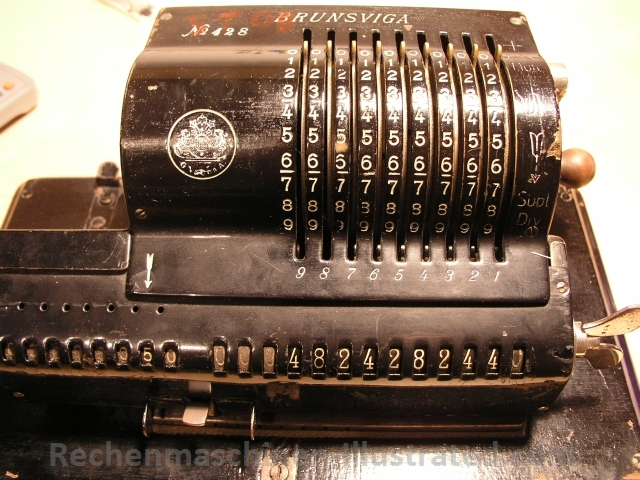
Another mystery short crank Brunsviga has surfaced in the IBM collection in New York, with serial number 806. We’re still trying to bring to the surface what this machine is exactly - it may have been sold in France by Chateau Frères. It's picture is featured on Valéry Monnier's website about 19th century calculators. It has the large wingnut on the right hand side and a bell.
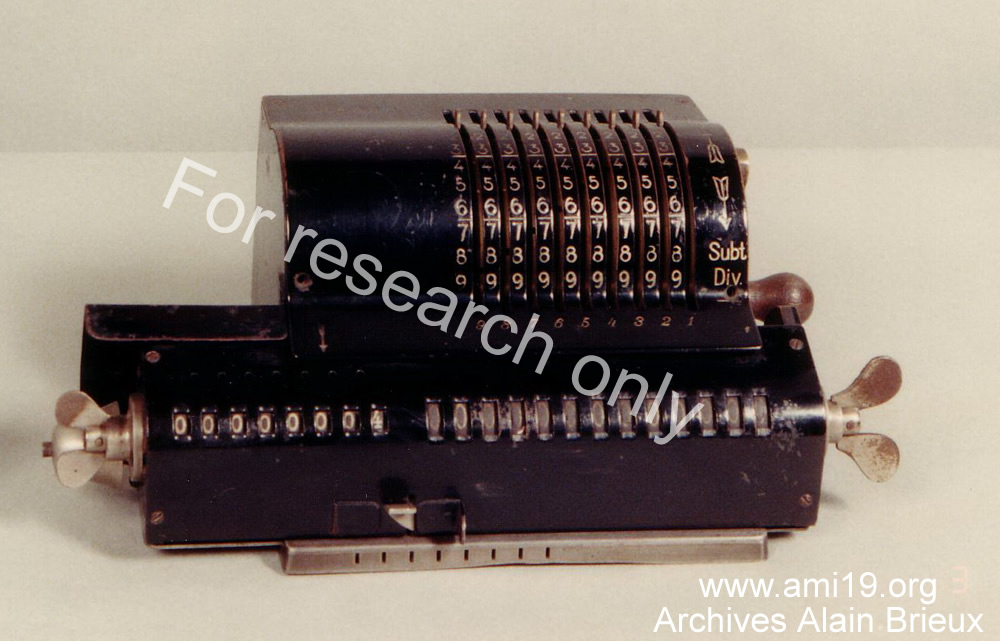
Brunsviga N° 490 is in the Tekniska Museet in Stockholm, and they kindly allowed me to use this picture of it, while the copyright remains with them. Note that the machine has a long crank (first known occurence of a long crank in these machines), the old style of carriage shift knob, and the new style of case lock. We see here for the first time holes appear over the result register to use the comma indicators there as well. There is no bell. Again the museum is aware of the history of the machine, which came to them in 1931 as part of the estate of the engineer Hjalmar Sandberg who worked on heavy engineering projects, such as blast furnaces and hydroelectric plants.
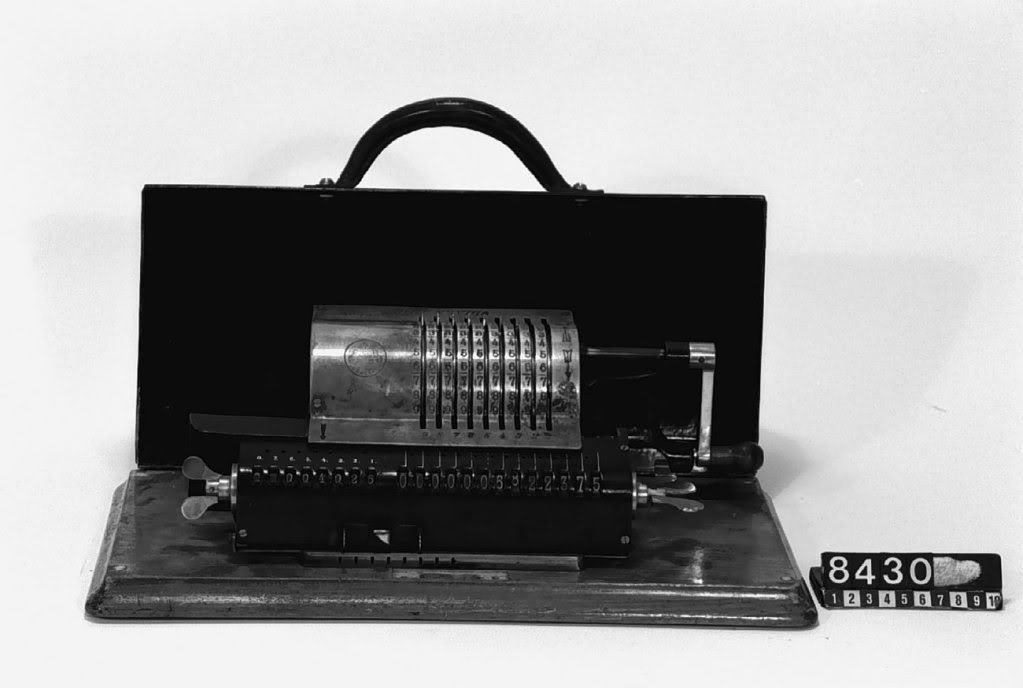
Brunsviga N° 506 was sold on ebay-Kleinanzeigen - this is the last known machine with the logo placed lower on the setting register plate. It does have the Brunsviga script at the top.
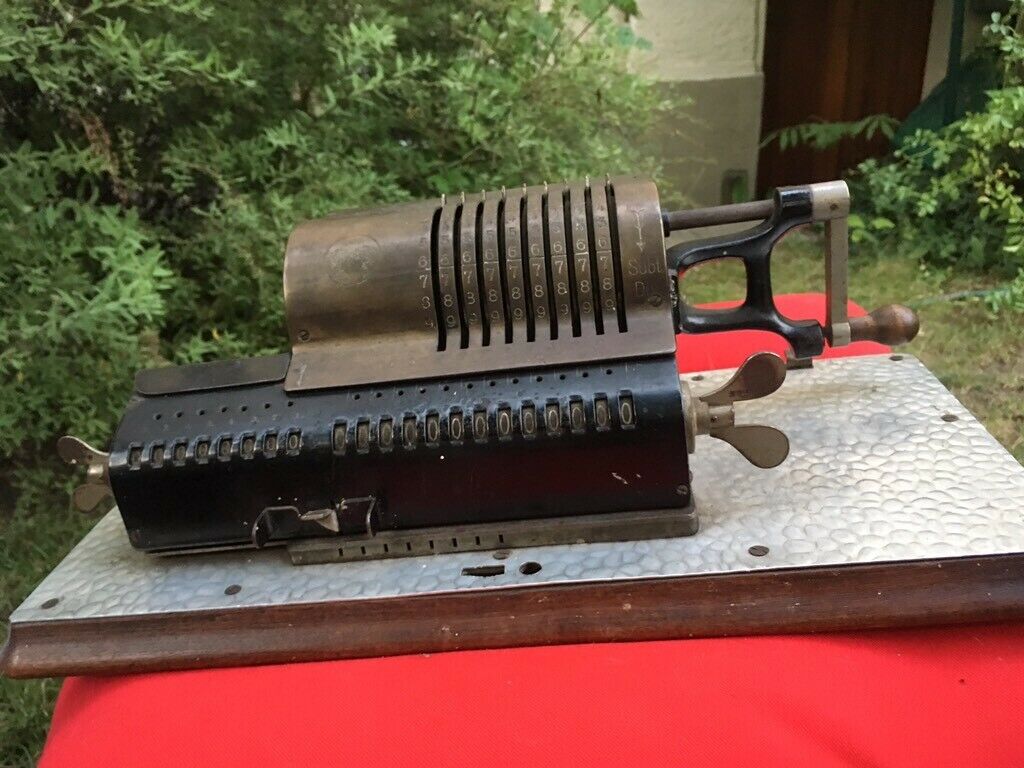
A fellow collector has N° 512. This machine is the first of a series with the logo stamped higher into the setting register plate, at the height of row 4, as opposed to between rows 5 and 6, and no "Brunsviga" script on the top plate, just the logo.
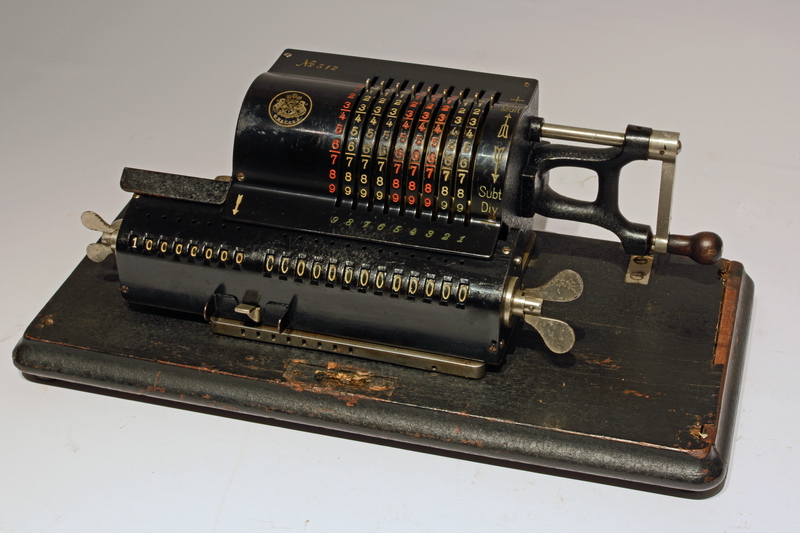
N° 529 was in a private collection in France, until sold on ebay, and is equipped with a long crank and a bell. It has the serial number stamped all over the machine, including on the (long!) crank. Comma holes over both registers. Again, no Brunsviga script, and the "high" logo.Picture by Valéry Monnier, used with permission.
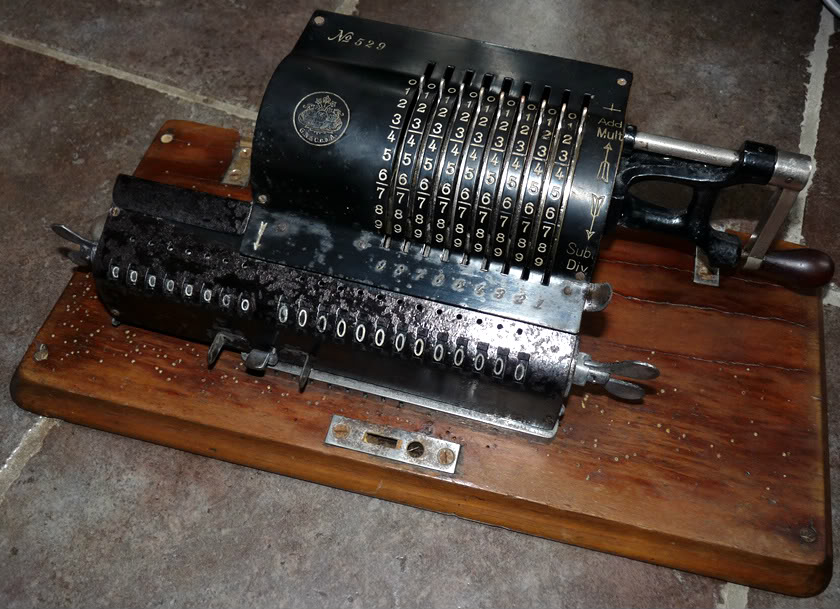
Freddy Haegens' website (unfortunately defunct) listed Brunsviga N°579 ...also with a long crank. According to the owner, there are no markings on the machine that correspond to the serial number on the top plate, and it is possible that an earlier top plate has been transplanted to a later machine. The plate has no "BRUNSVIGA" logo, and it has the vignette stamped higher, like the previous machine. There are again comma holes over both registers, but the revolution counter clearing wing nut is the small model.
At the Braunschweigisches Landesmuseum is N° 633, which has more patents on the side, and a very strange logo, which is a medallion on top of the cover instead of a stamp into the cover. In addition, this vignette is again lower, in the old position between the rows 5 and 6. Also the "BRUNSVIGA" name is applied in this manner. There is a comma slider bar on both carriage and setting register, and no holes at all for comma pointers, no bell, a short crank, and a small wingnut on the revolution register. The top plate is nickeled, where earlier ones are brass, or painted black.
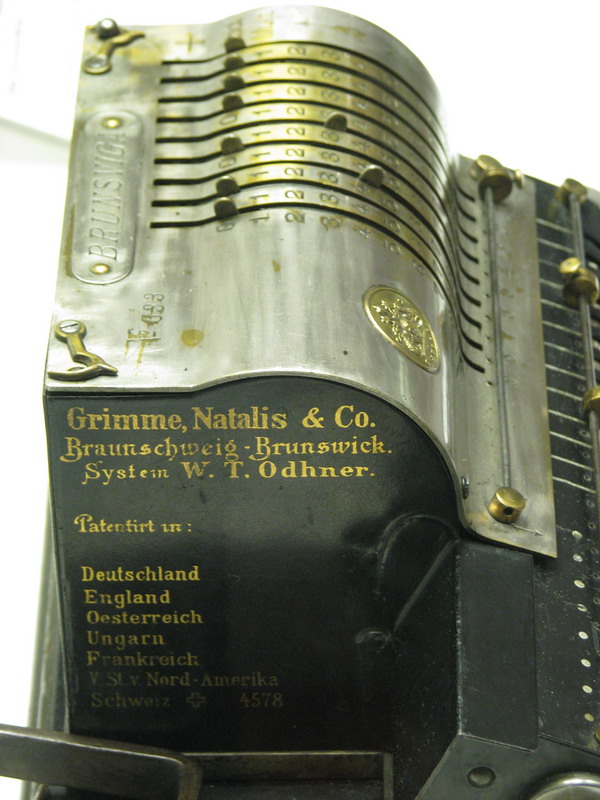
I have written an article in Historische Bürowelt N°94, where I demonstrate systematically that this machine is not actually a short crank Brunsviga, but rather Odhner's Arithmometer N° 633, constructed in St. Petersburg in 1891, and sent to Braunschweig as a study model after they acquired the patents. It was later Brunsviga-ised with new logos borrowed from the sewing machine production, new paint, and new decals. This also makes it plausible that the cutoff for the short cranks was somewhere around machine N° 450, and afterwards only long-crank machines were still produced.
No other machines with these ornate logo's have been found, except for the one below, N° 739 which is also in the factory museum, and in the original catalog carries the mention that the manufacturer's log carries the remark "Schlosser Orig. Odhner", which implies that it is an Odhner machine similarly adapted (this time with a long crank, new paint and logos). This machine has 9 x 8 x 15 capacity instead of the usual 13 - which is atypical at best, and necessitates an adaptation to the counter mechanism as well. It has comma holes over the counter register only, a long crank, no bell, and a smaller revolution register clearing wingnut.
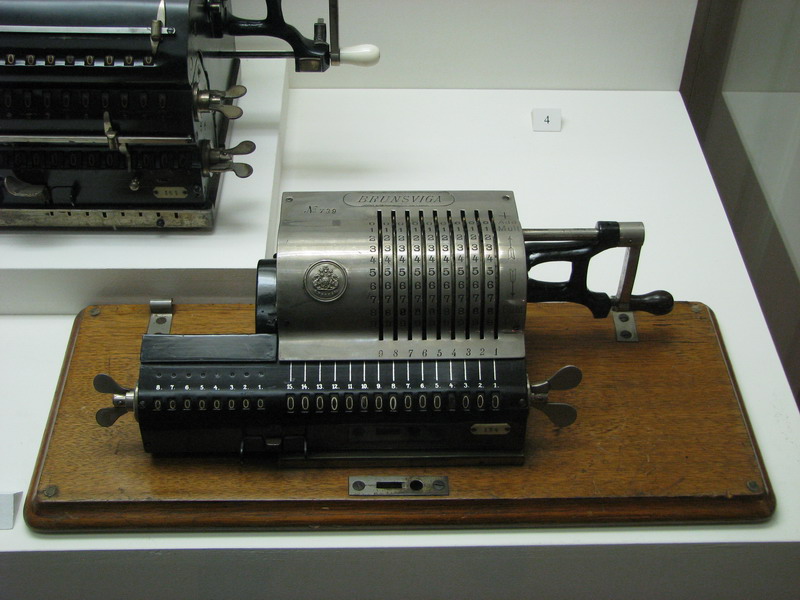
In June 2005, Breker sold Brunsviga N° 3340 ...with a short crank and no bell. What they failed to mention in the description is that it has capacity 7 x 8 x 10, making it a Model C. The grip on the handle is certainly not original and looks to have originated from a Triumphator machine. Pictures © Auction Team Köln.
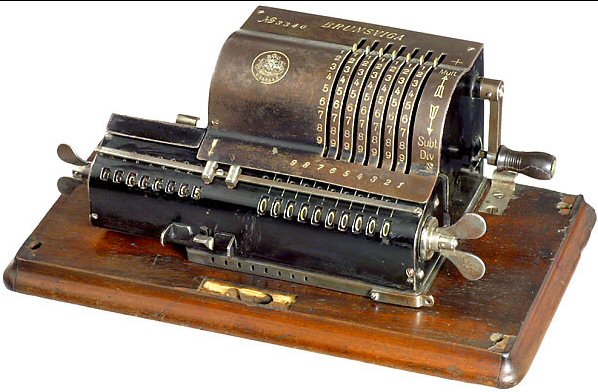
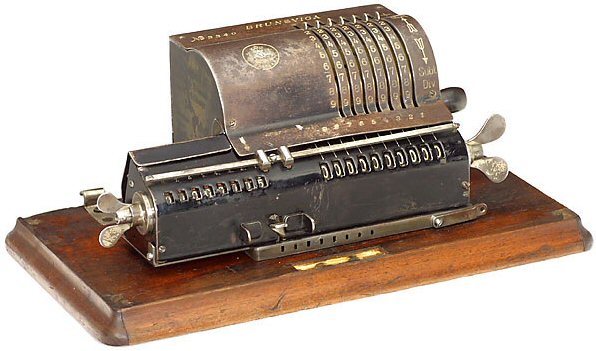
That makes a total of 29 early short-crank Brunsviga machines still in existence, with serial numbers between 73 and approximately 450. At 6,5% of the production run, there is certainly still the possibility for improvement!
If anyone else knows of any other Brunsviga Model 1 machines, let me know!
